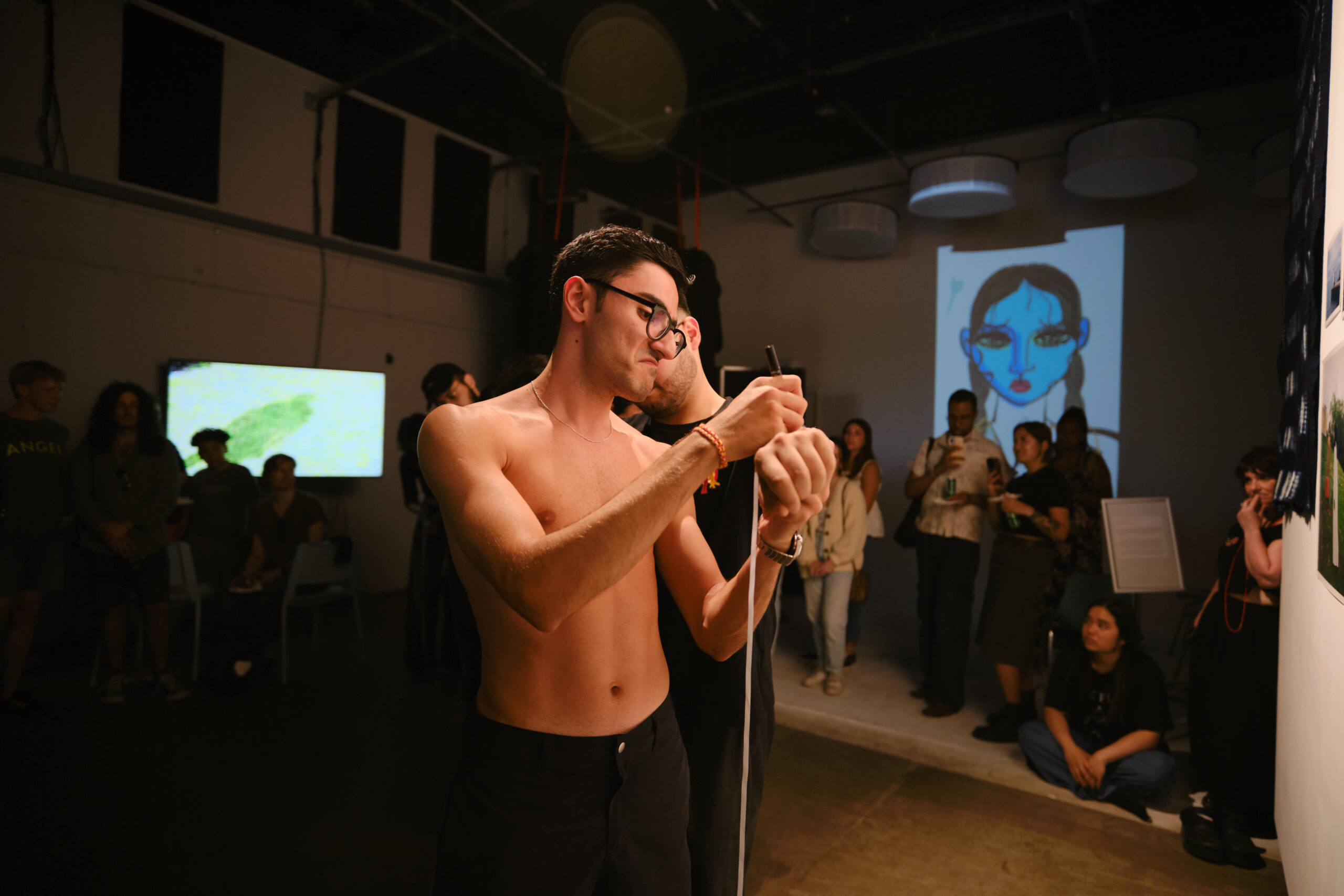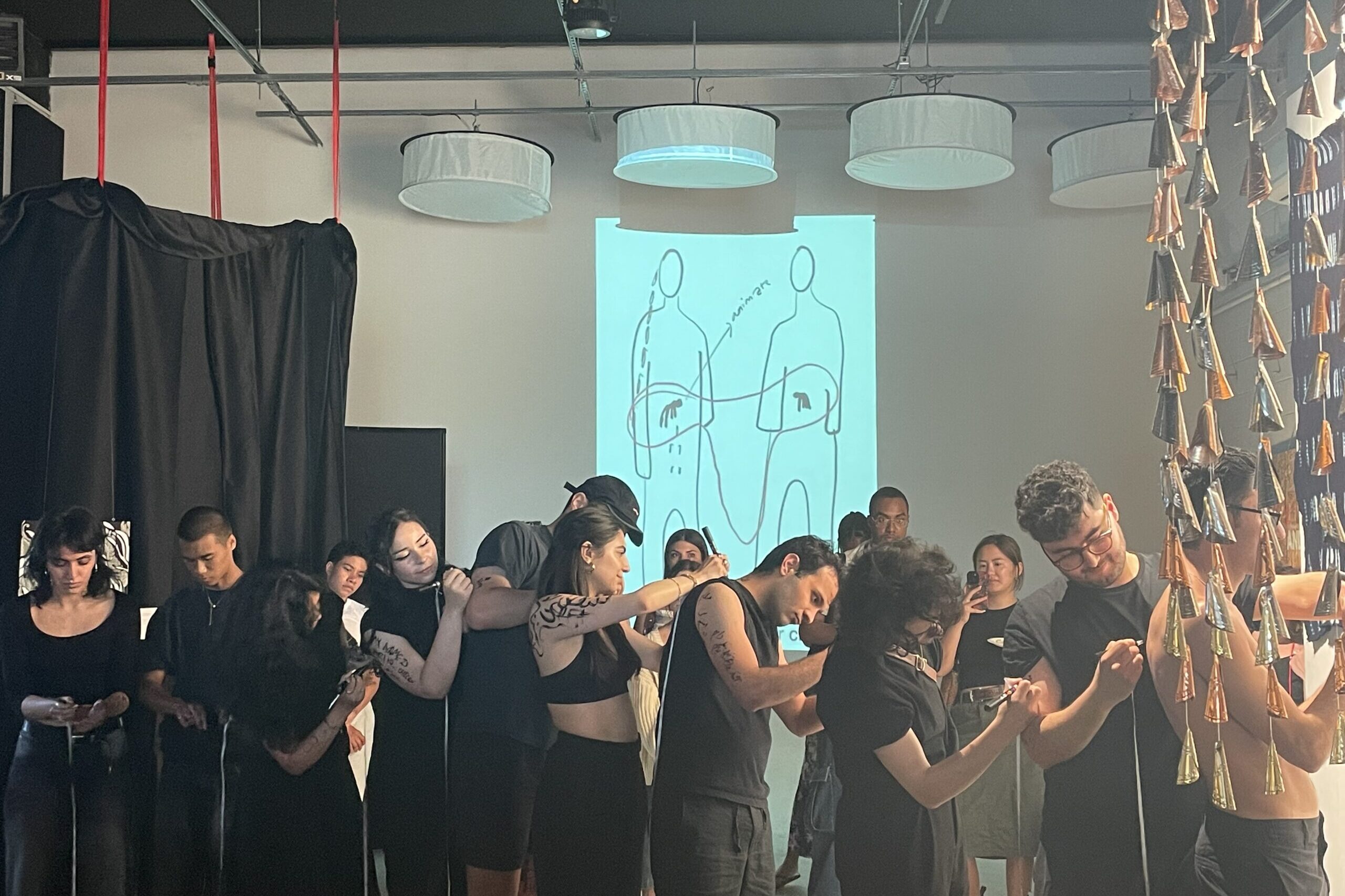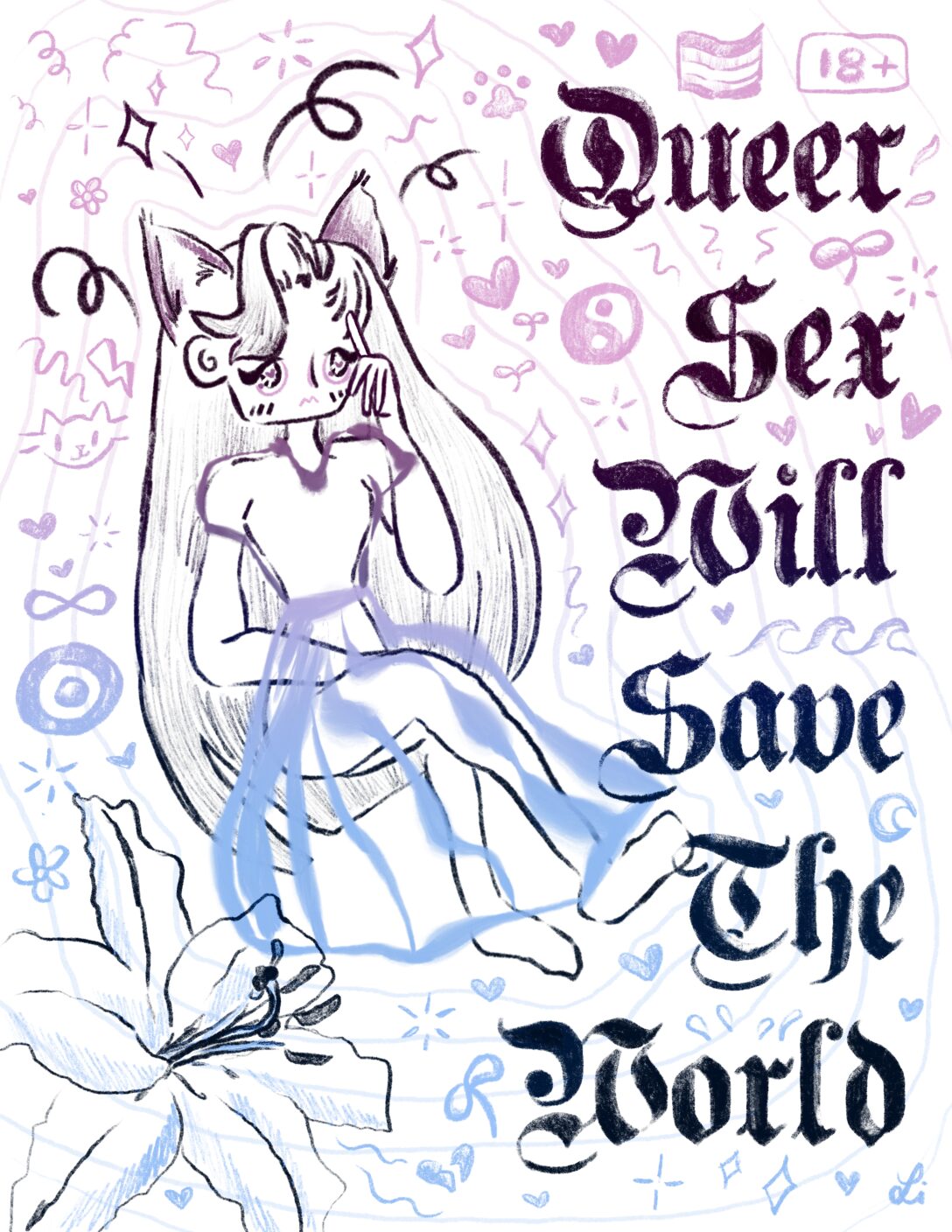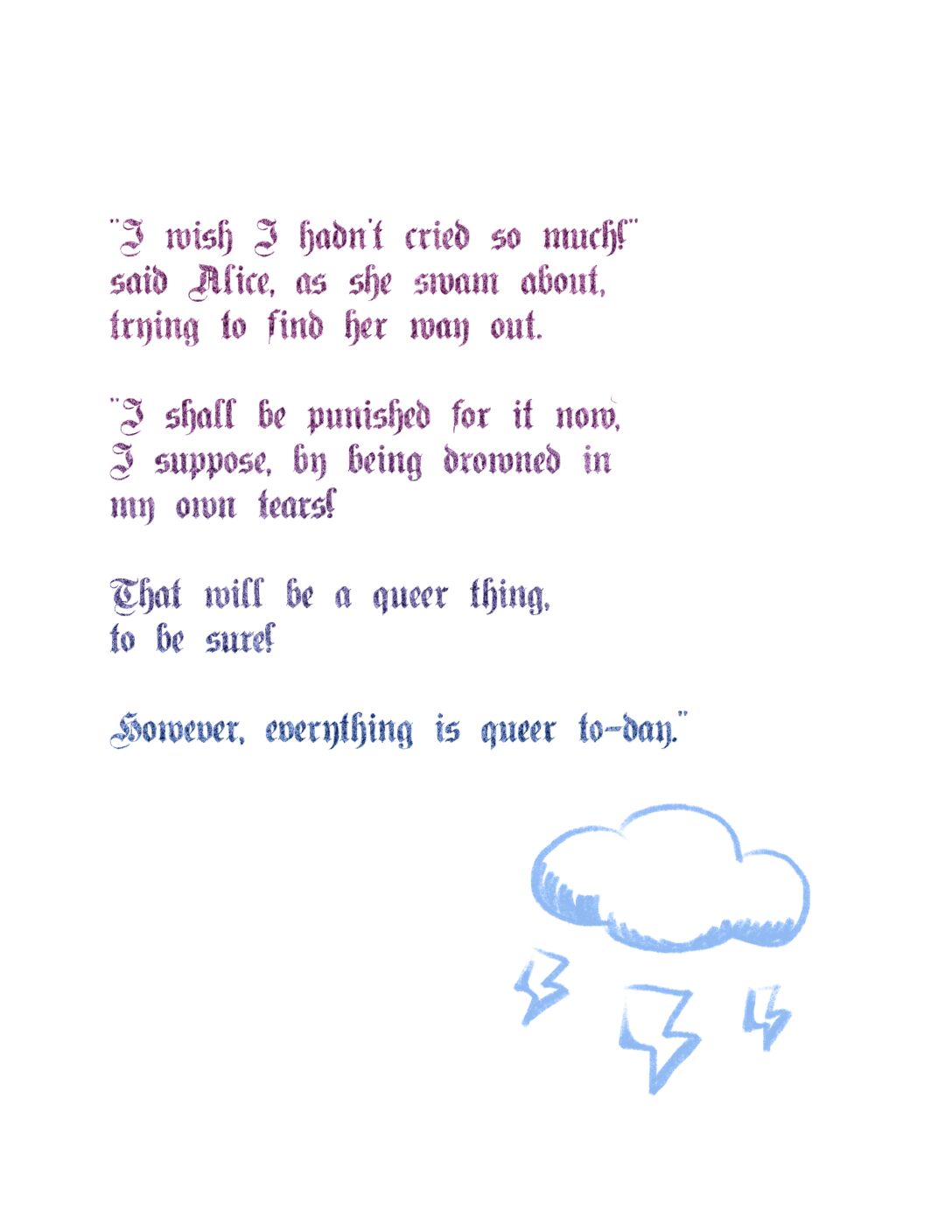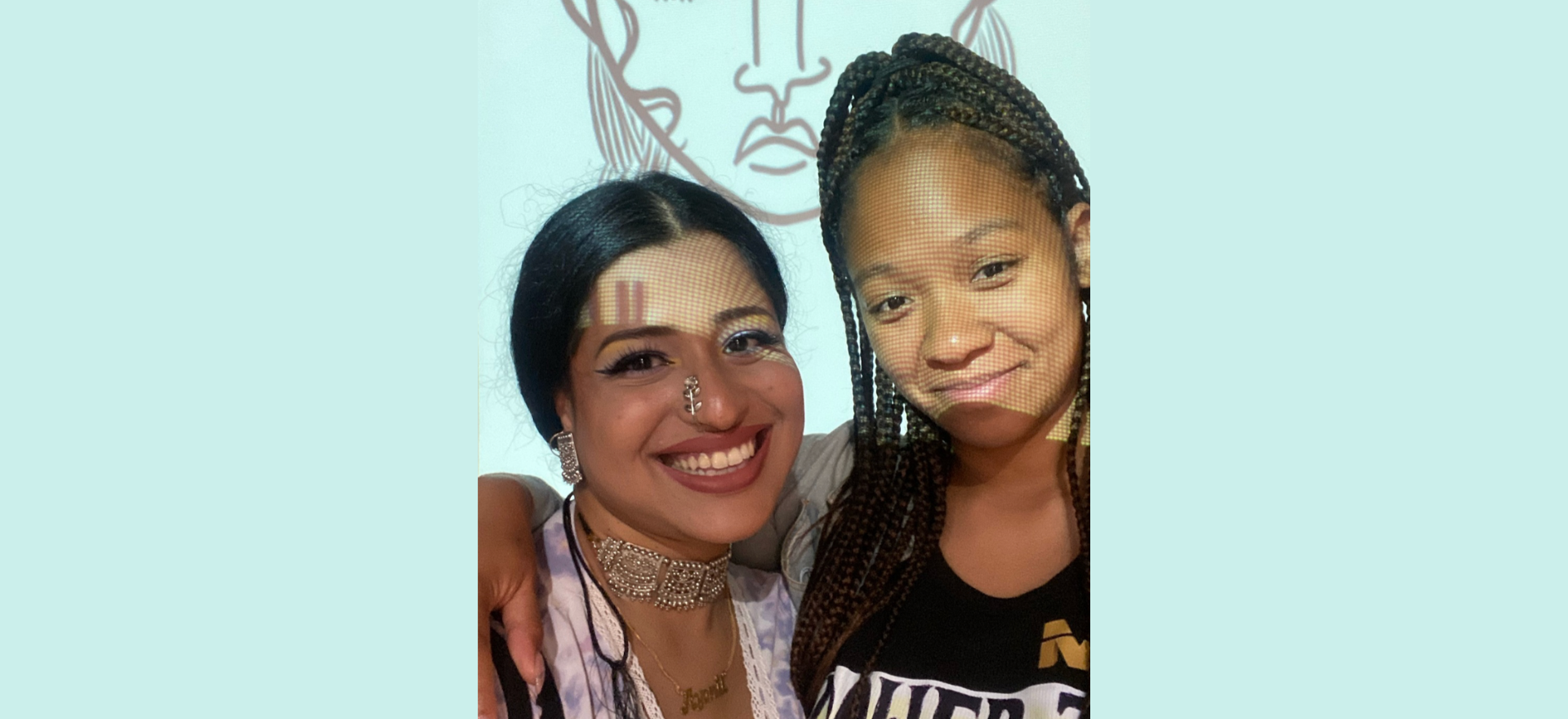Over an 18-month period, 18 racialized and gender diverse artists took part in creative research to develop artworks and activations responding to the guiding question “What change do you want to make with your art?”.
Their work culminated in their group exhibit Trajectories of Now: An Anthology. Through visual, audio, and tactile works, Trajectories of Now documented critical narratives of relationships to identities; both personal and collective.
Discover the artists and their artworks and aesthetic advocacies below.
Meet The Artists

Ashley Beerdat is a painter, muralist and arts educator. Guided by her intuition and synesthetic connection between sound and colour, Ashley relies on material sensation to navigate the pictorial and formal construction of the canvas. Each painting is a conversation with nature and through it she finds nature is an ancient survivor, far more intelligent than human absurdity.
Ashley T.
Ayonti Mahreen Huq is a Bangledeshi-Bengali artist who uses both traditional and digital media to create vibrant, surrealist images and animation. Her work is heavily guided by the female gaze and the desire to be playful and experimental.


Blessing O. Nwodo is an award-winning storyteller and feminist activist, who works in various mediums, including film, fiction, poetry, nonfiction, and more. She holds an MFA from the University of Guelph. When she’s not relishing fashion, she can often be found pulverizing the patriarchy. She is working on a collection of speculative fiction, and a novel.

Bernice Mwaura is a visual artist from Nairobi, Kenya, currently based in Toronto, Canada. Drawing from interdisciplinary interests she utilizes photography, film and further visual mediums to tell her stories.

Bert Whitecrow is a 2-spirited Anishinaabe multidisciplinary artist from Seine River First Nation (Jiima’aaganing). Their work centres visual storytelling, preserving and practicing ancestral knowledge, explorations of Indigenous futurisms, and their relationship to place.
Claire Tran is a student studying in Seneca’s Animation program. She’s interested in exploring the movement of cultures and their representations. Claire’s an enthusiast of all things art, and enjoys dipping her hands in multiple different mediums and art forms. As long as she can tell a story with it!


Edan Maxam is an Afro Indigenous / Latinx photographer, printmaker and muralist born and raised in T’karonto. Her work discusses themes of identity, family history, oral storytelling, healing and activism. Edan continues to do work in community arts as an art educator who supports BIPOC youth.
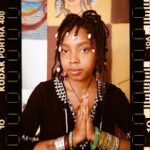
Ehiko Odeh is a multidisciplinary artist, arts facilitator, arts educator, memory worker and researcher, whose work is rooted in mysticism and play. Through various media including painting, collage and textiles she intertwines themes of African coiffure, sovereignty and wellness.

Ezra Li (‘E’, Citizen Li) is an artist and filmmaker traversing queer, trans, and racialized identity politics. His work gestures towards a horizon defined by the radical embodiment of queer racialized lives. Studied in filmmaking, he works in video, animation, as well as in graphic design. As a genderqueer Chinese artist and Canadian immigrant, he strives to expand creative growth opportunities for queer, Asian, and otherwise marginalized communities.

Gloria O’koye uses the power of her voice to tap into the creativity and ingenuity of the voiceless and unheard in our society. As a multidisciplinary artist she draws on the power of storytelling and artistic expression to shed light on social and cultural realities.
Maggie Chang is a poet, writer and artist, whose pieces often focus on themes of environmentalism, international feminism, and identity – particularly the joys and sorrows of being Chinese-Canadian.
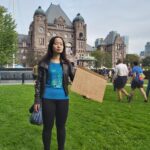
Michelle Ma

Lanni Pettiford

Nabeela Malik is a Toronto based artist specializing in Arabic calligraphy, geometry and metalsmithing. Through the use of light manipulation, architectural elements and language she creates immersive experiences that are layered in meaning and depth through her combination of scientific, historic and religious research.
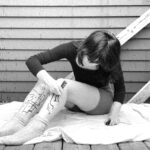
Neshat Neishabouri is an Iranian multidisciplinary artist and designer. Her work is often an exploration/ inquiry into topics of Southwest Asian Identity, socio-political censorship, and our spiritual connection to land.

Olympia Trypis is a self-taught, multidisciplinary artist, who uses artwork and natural materials to express themselves and relate to the world around us. They are passionate about using art to heal relationships with ourselves, community, Mother Earth and all of our relations.
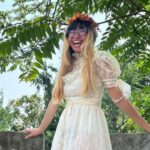
Vincy Lim is a Chinese-Canadian non-binary lesbian disabled award winning cartoonist, multimedia illustrator, and workshop programmer. Blurring the line between memories, the subconscious, and day to day actions, they create dreamy worlds which we are invited into for an intimate heart to heart conversation.
Experience their Artworks & Creative Advocacies
GLORIA O’KOYE (GLOWZ) & AYONTI MAHREEN HUQ
The Human In Us All (2024)
Immersive Installation with Audio Recording
6:38 min. Audio. Mixing by Jane Doe Smith.
The Human In Us All is an audiovisual storyscape illuminating voices and experiences of Black and Indigenous women in the incarceration system. Artist Gloria O’koye (aka Glowz) draws on narratives based in lived experience to shed light into what goes on behind prison walls. She seeks to bring increased awareness to barricades experienced prior, during and post incarceration, and how each stage is fought with challenges, stigma and misunderstandings. How does society meet people halfway? The visual imagery for this piece was developed in collaboration with fellow Trajectories artist Ayonti Mahreen Huq, who worked to bring Glowz’ visions to life. The resulting image shows two women with their braids intertwined, holding on to each other for strength. Their wombs are reflected using a vulvar shape showing the inner child crying. The cut braid of the Indigenous woman represents her isolation from communities, culture, traditions and teachings. The artists envisioned the women in an open-field with fresh green grass, beautiful sky and winds, to counter the cold realities of incarceration. The final piece combines Ayonti’s imagery with Glowz ‘ powerful collaborative spoken word poetry, to highlight complexities that individuals go through in life. The work seeks to resist the ways in which people’s voices get shunned or judged the moment they open up about these journeys. And to open doors on how incarceration impacts loved ones and communities.
MAGGIE CHANG
My Ancestors Footsteps & The Land Here Series (2024)
Black and White Photographs on Foam Core
24 in x 36 in each
Artist Maggie Chang shares her artist statement as a personal reflection: “My Ancestors Footsteps & The Land Here is the result of a years-long journey to amplify the stories of BIPOC youth doing sustainability and environmental work. Through my undergraduate thesis research, I heard rich stories from the BIPOC youth participants that just don’t get told in relation to sustainability here in so-called Canada. I wanted to give them a platform. I also learned that many BIPOC youth wanted, and needed to see themselves in the field to feel safe in it, so these photo portraits are a direct act to help create that space. In the years since, I realized as well, that the rupture in relationship to the land of one’s ancestry is something that creates wounds, and I wanted to create space to explore, and heal that through stories. For me, for the participants, and everyone holding and bearing witness to them. When I embarked on the journey for this project, I envisioned photographing and curating images of badass eco-warriors to show off what we are capable of. Through the process of co-creation and working with each participant to capture their image and story, I was also reminded to not forget about the joy. And that joy is also reflected in this project now. Because while so much of our work is frightening, and existential, and unfairly borne by us due to injustice, there is also so much joy in it. In the being. In the wonder. In the community – between us and our more than human world. All of our relations.”
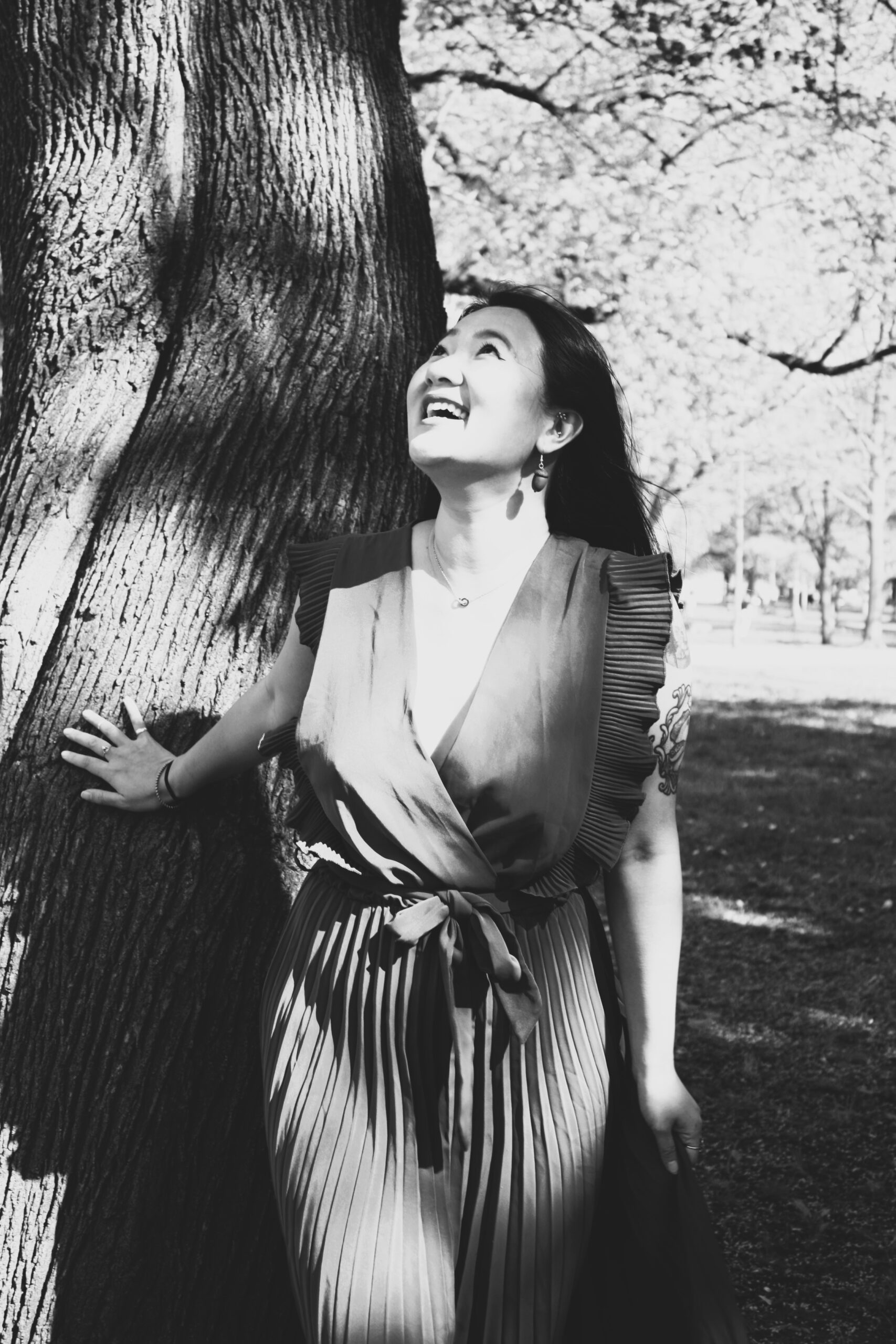


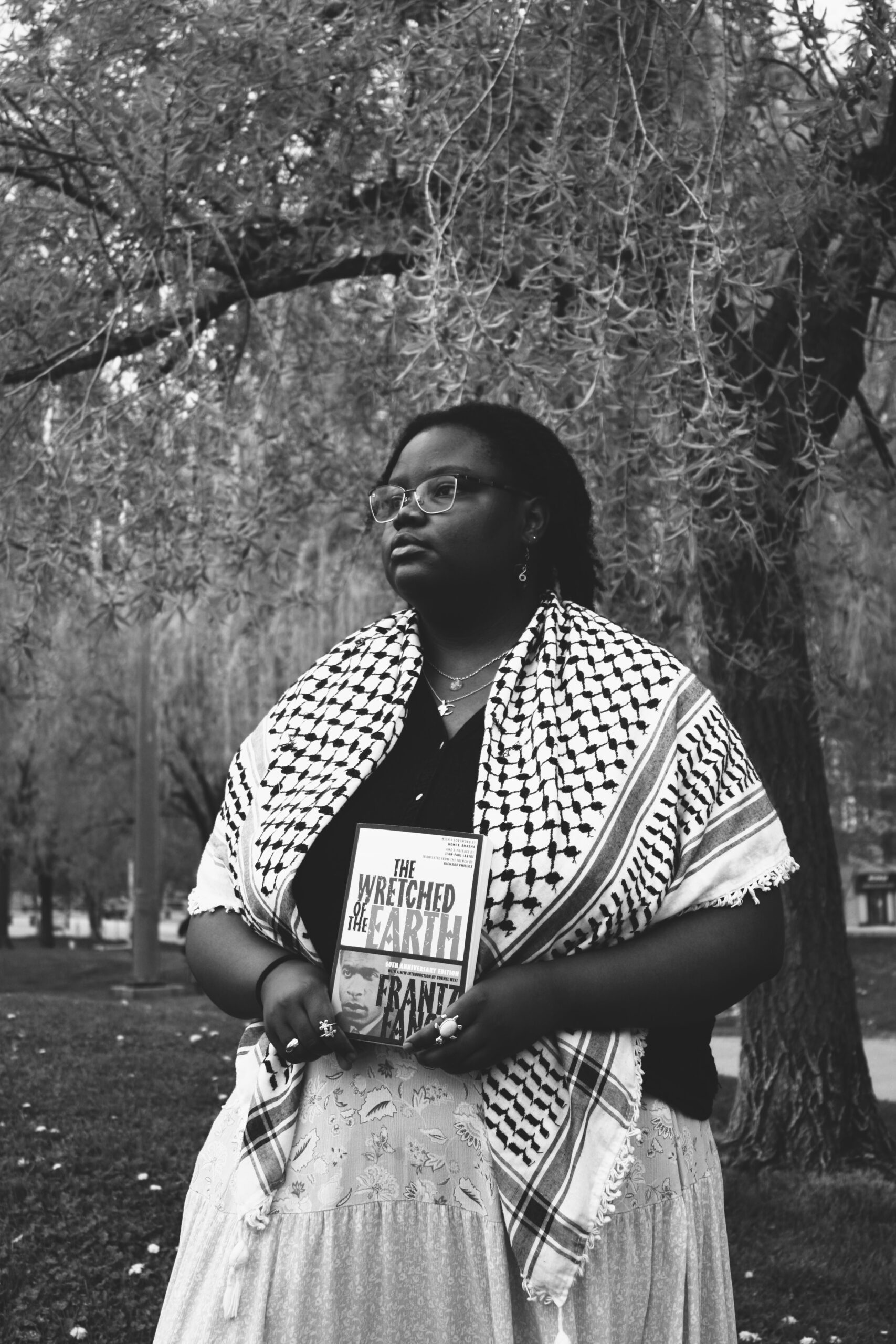
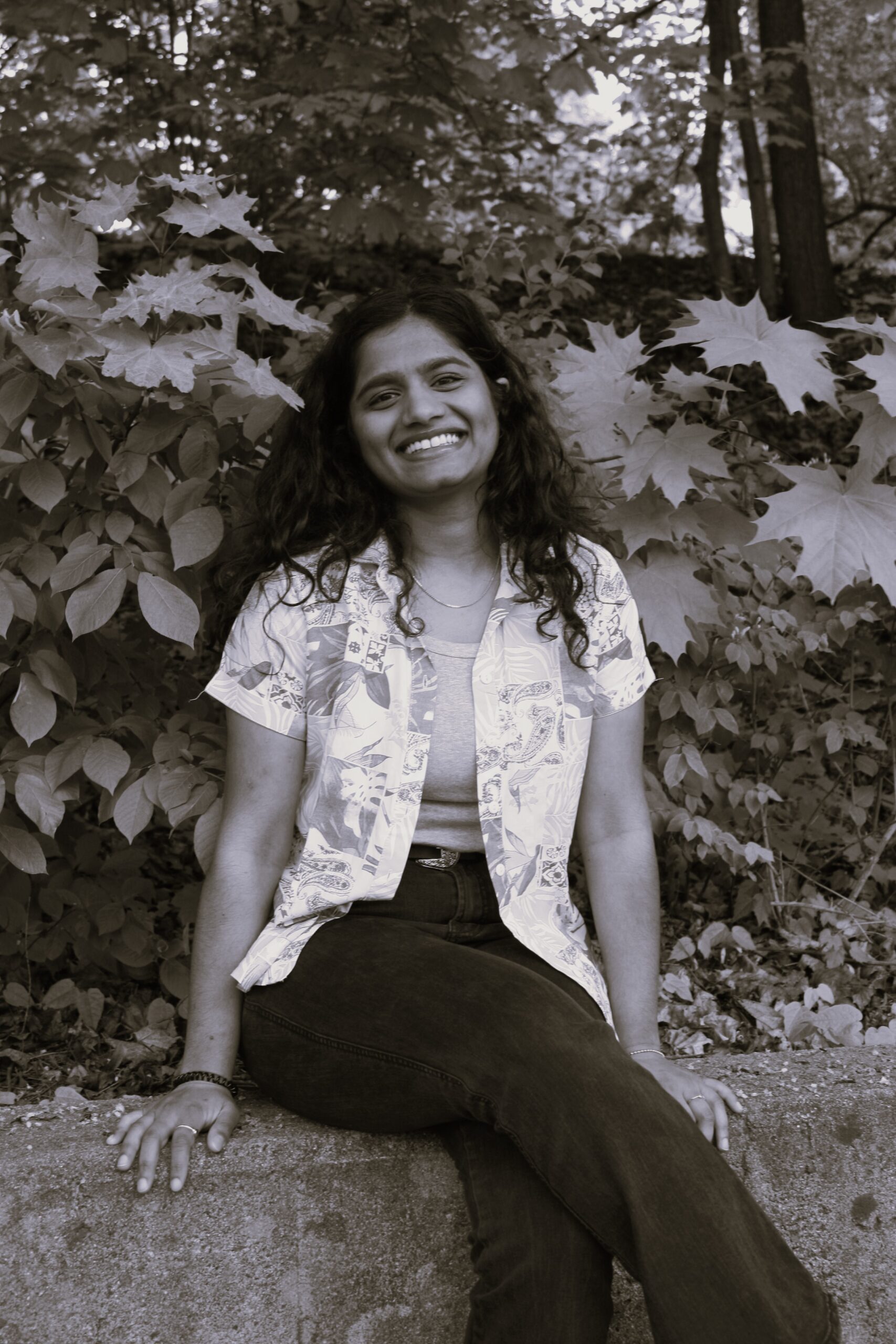
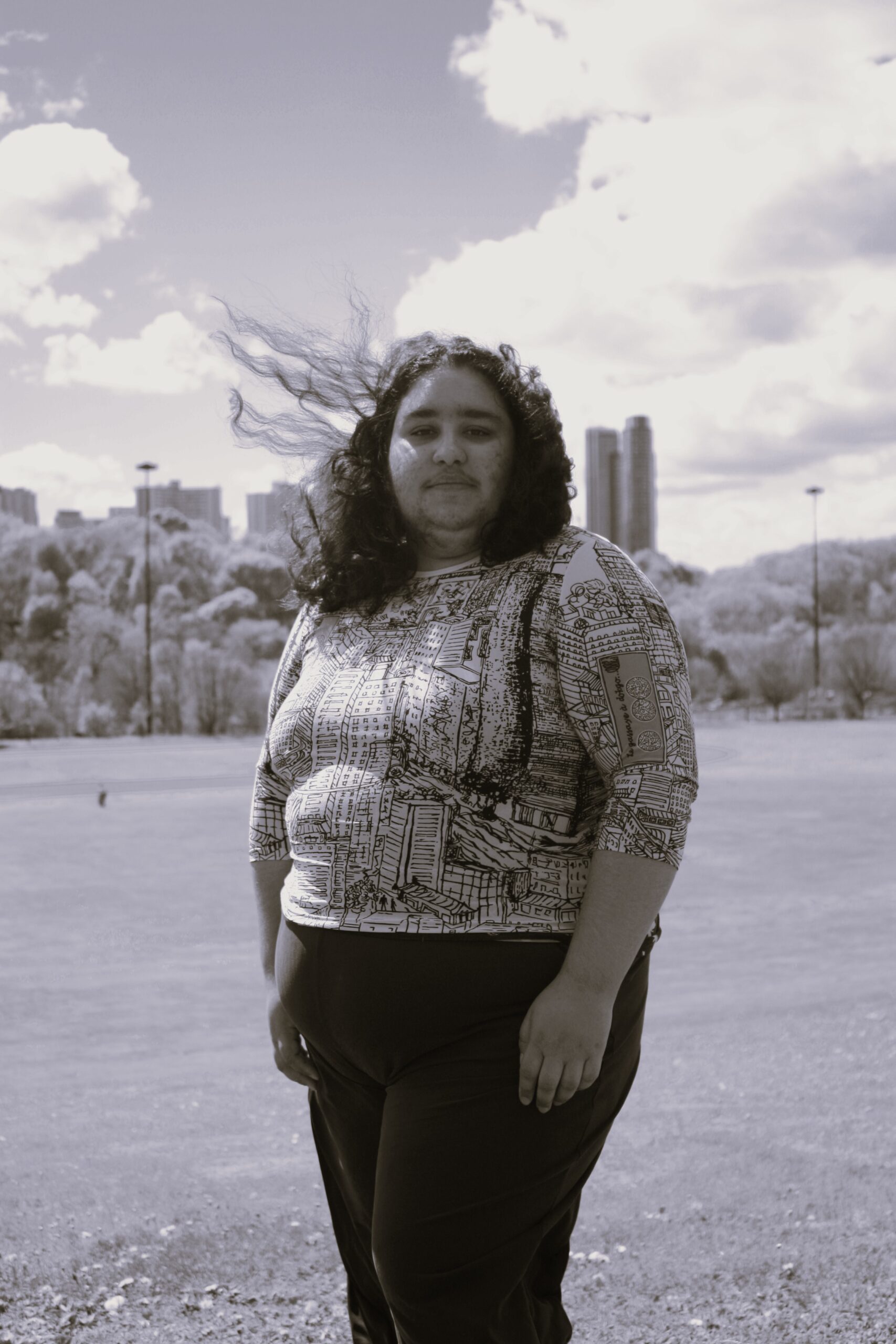

NESHAT NEISHABOURI
‘KhotootinBlue’ (2024)
Performance
‘KhotootinBlue’ Series (2024)
Markers on canvas boards
15 in x 20 in each
KhotootinBlue translating to ‘Lines in Blue’, is a performance that explores the pressing issue of political art censorship within art institutions. Artist Neshat Neishabouri seeks to challenge the notion that art should not be recontextualized to conform to political agendas. She believes that art holds the capacity to provoke, question, and reflect the complexities of our world, and to censor it is a profound betrayal of its intrinsic purpose. Her participatory performance engages collaborators in a free journaling exercise, using the surface of the body, particularly the legs and hands, as a canvas for expression. Neshat views performance and writing as forms of expression that should not be censored, reinforcing the idea that these acts remain inherently free and true to their purpose.
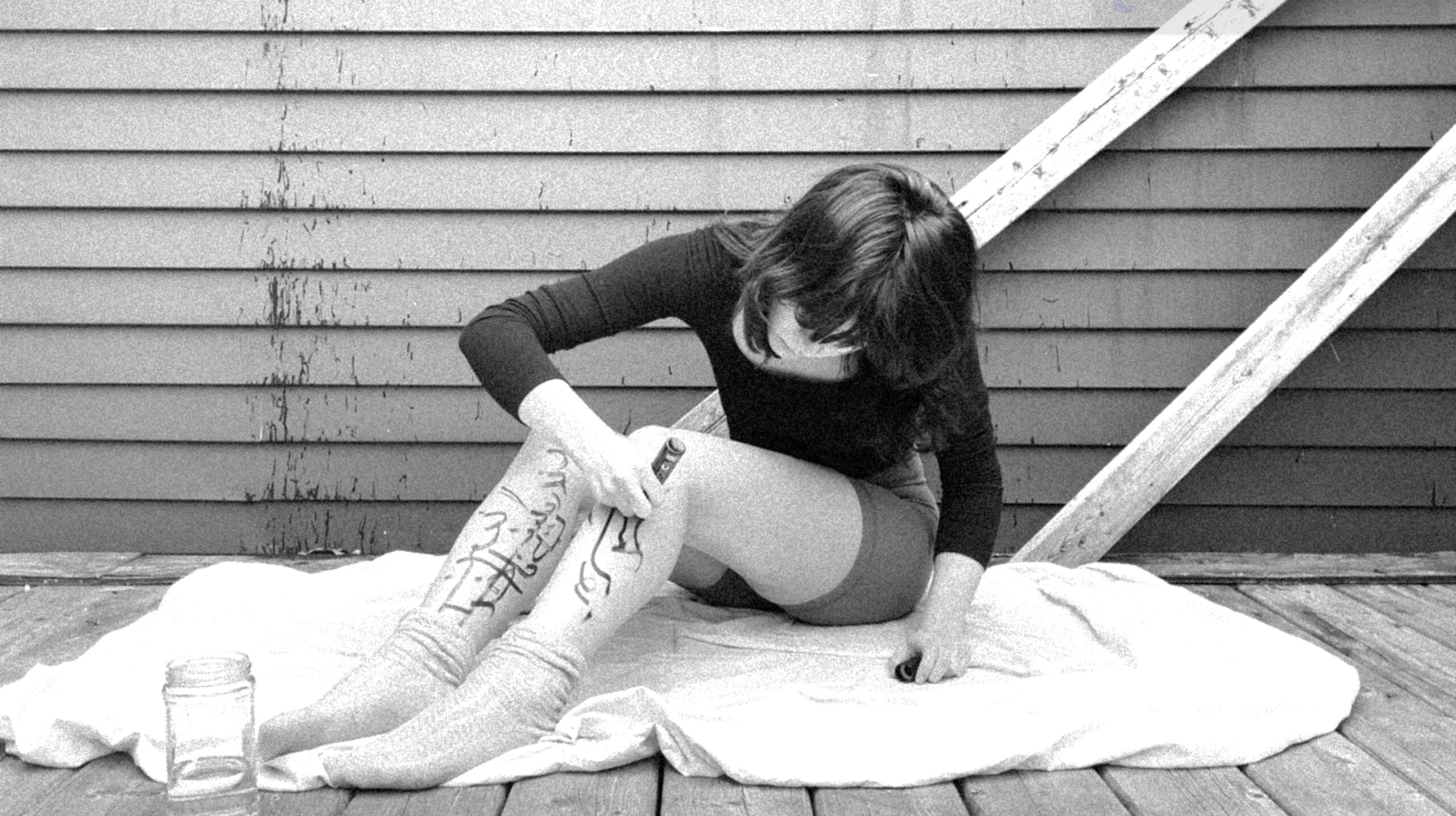
EHIKO ODEH
Becoming – Accounts From Lived (2024)
Video
17 min
Becoming – Accounts From Lived Experiences is an artistic tribute to honouring relationships, navigating ebbs and flows of addiction, and becoming whole. In this work of video collage, artist Ehiko Odeh explores wise narratives of love, resilience, and vulnerability. Relationships that persist in their journey are confronted with uncertainties, trials, and moments of profound connection. Through exploring themes of loyalty, adversity, faith, passion and pleasure this project delves into fragilities of human experience, offering a heartfelt exploration of the complexities inherent in the pursuit of radical joy amidst the challenges of recovery.
BERNICE MWAURA
We Leave This Place for Another (2024)
Colour Print Photographs
Various Sizes
We Leave This Place for Another is a photo series exploring diasporic dislocation, mapping a conceptual migrant trajectory. For artist Bernice Mwaura, this photo series conjures up all manner of questions; what does it mean to leave one place for another? How do we navigate the complex feelings; of desire, of fear, and of longing that often shape migrant experiences? Bernice draws on her background in Film and African Studies to tell stories of linkage, and leans on her own lived experiences as a migrant to shape this story. Migration is both coming and going; it is living in one place while dreaming of another. The photos in this series capture that in-betweeness. They reflect the constant state of change and dislocation experienced by those who move between cultures, and across geographies and identities. Each frame is an attempt to grapple with the ephemeral nature of such existences – the landscapes that shift under our feet, and the skies that stretch across borders. In this series we follow two young souls who’ve embarked on their journey; leaning on each other and the few things they can carry with them. A small suitcase, a lamp to light the path and a stool to rest on when the journey gets weary. The photos invite us to follow their journey, from there to now.


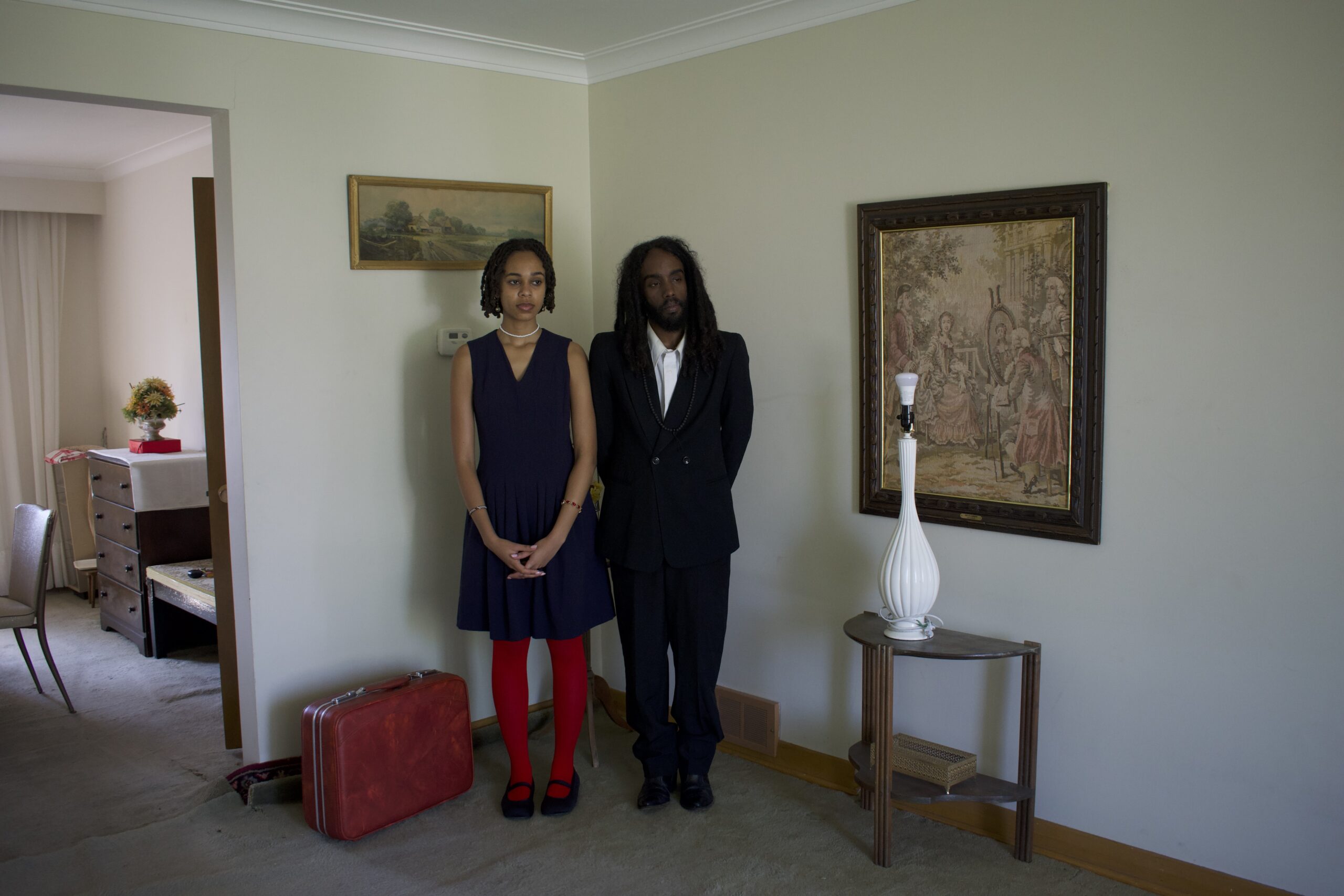


ASHLEY BEERDAT
The Rhythm of Sensations (2024)
Acrylic, Oil crayons, Neon pigments, Ink on Canvas
16 ft x 5ft
The Rhythm of Sensations is a durational live painting activation exploring intuition, feelings and landscapes of recognition and abstraction, like the release of a long breath. As a first-generation diasporic artist of Guyanese descent, Ashley Beerdat’s interest in landscape painting is two-fold. She situates herself in the present, wherever she is geographically located. While also engaging with speculative imagination, by exploring the flora and fauna of the region that her parents are from in West Coast Demerara, near the Amazon rainforest. Using elements and references from both geographies, she invents post-apocalyptic worlds as a response to present-day ecological crises, to find hope. For Ashley, painting, like geology, is an accumulation of deep time built through variations of gesture and layers of paint, arising from a process of experimentation and intuition. In this accumulation, the trajectory of each painting varies through surface treatments informed by colour, sound, erasure. Her subject matter based in landscape oscillates between recognition and abstraction, to produce evolving fields that end with a recurring narrative; a portrayal of nature prevailing through catastrophe. She composes catastrophe through chaos by way of gestures that occupy the whole canvas, intermingling this chaos with close inspection, revealing creatures and plant life with anthropomorphic and naturalistic qualities that appear and disappear. The final compositions contain a multitude of beings, some recognizable and others invented, all dispersed across the canvas with no central perspective—a way to honour all creatures, trees and insects as equal. Thus interconnectedness is privileged over hierarchy, and painting becomes an intervention towards envisioning a future with hope.
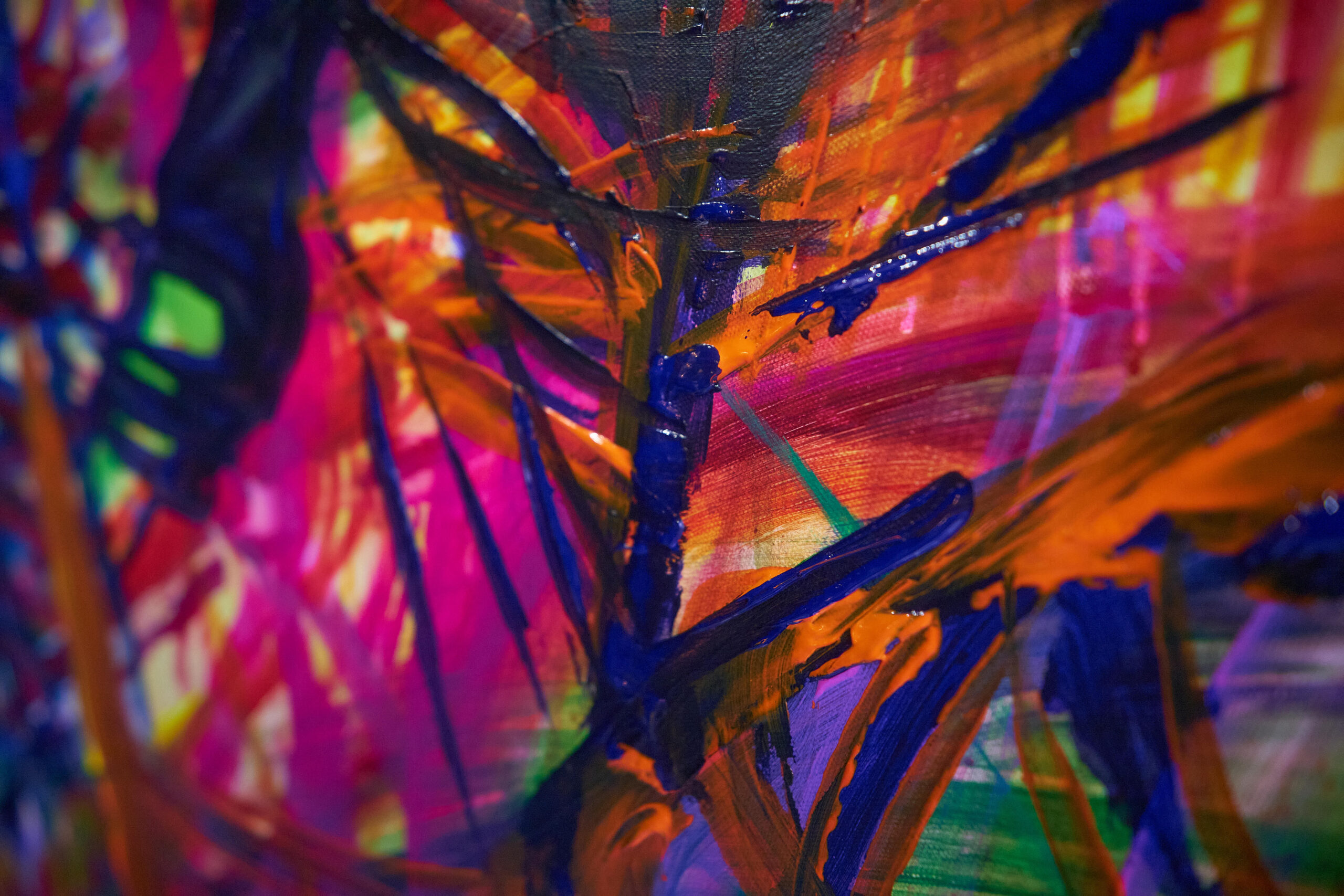
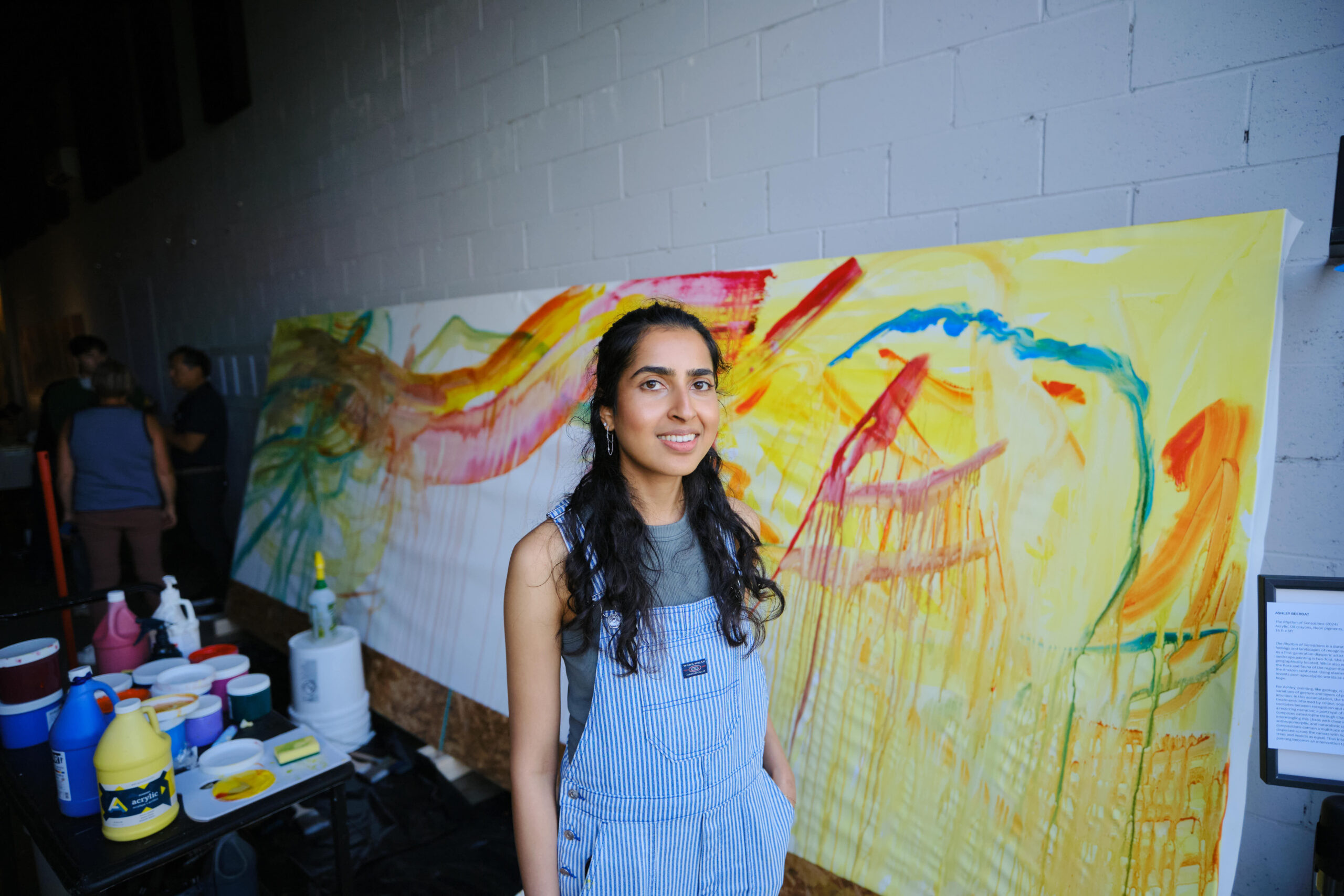

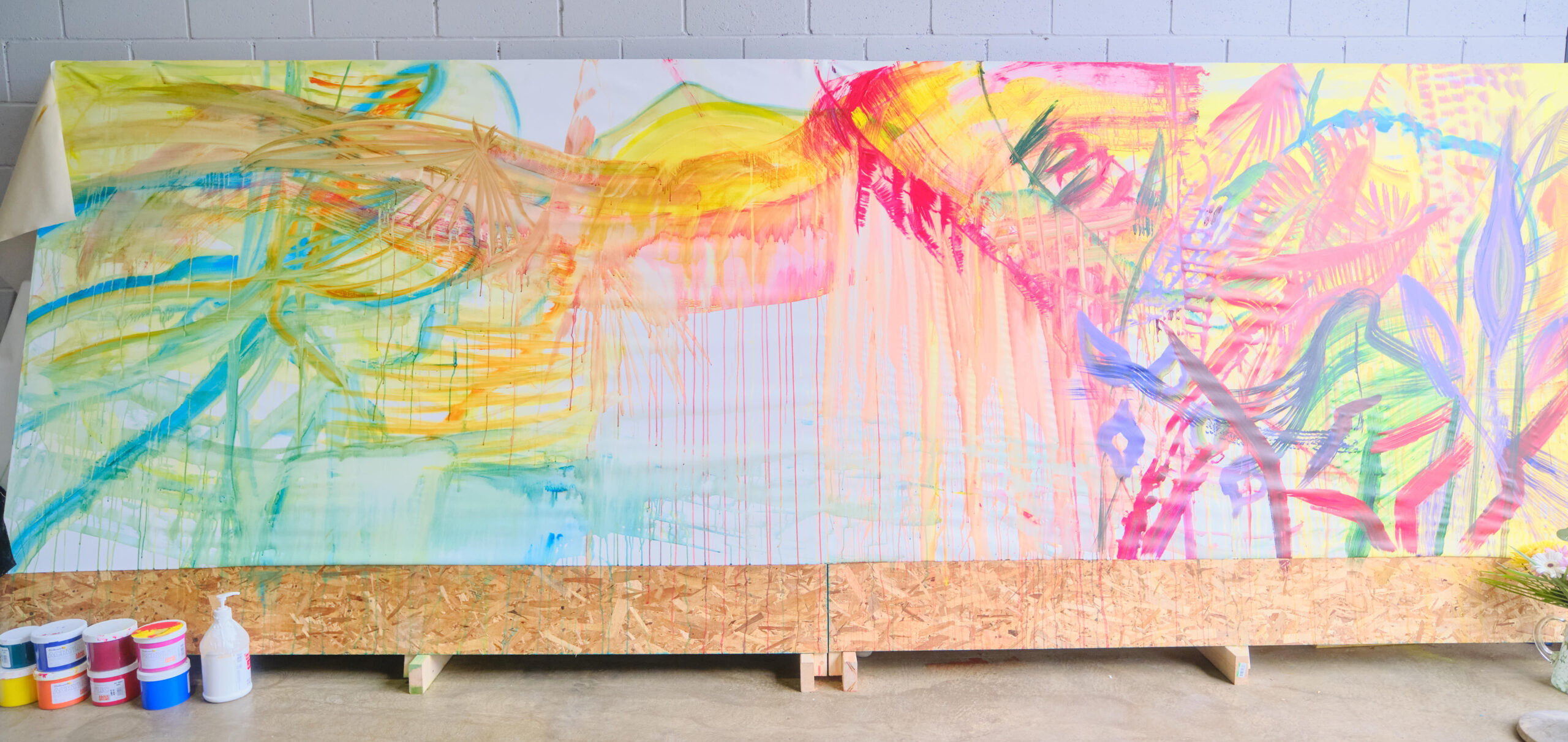
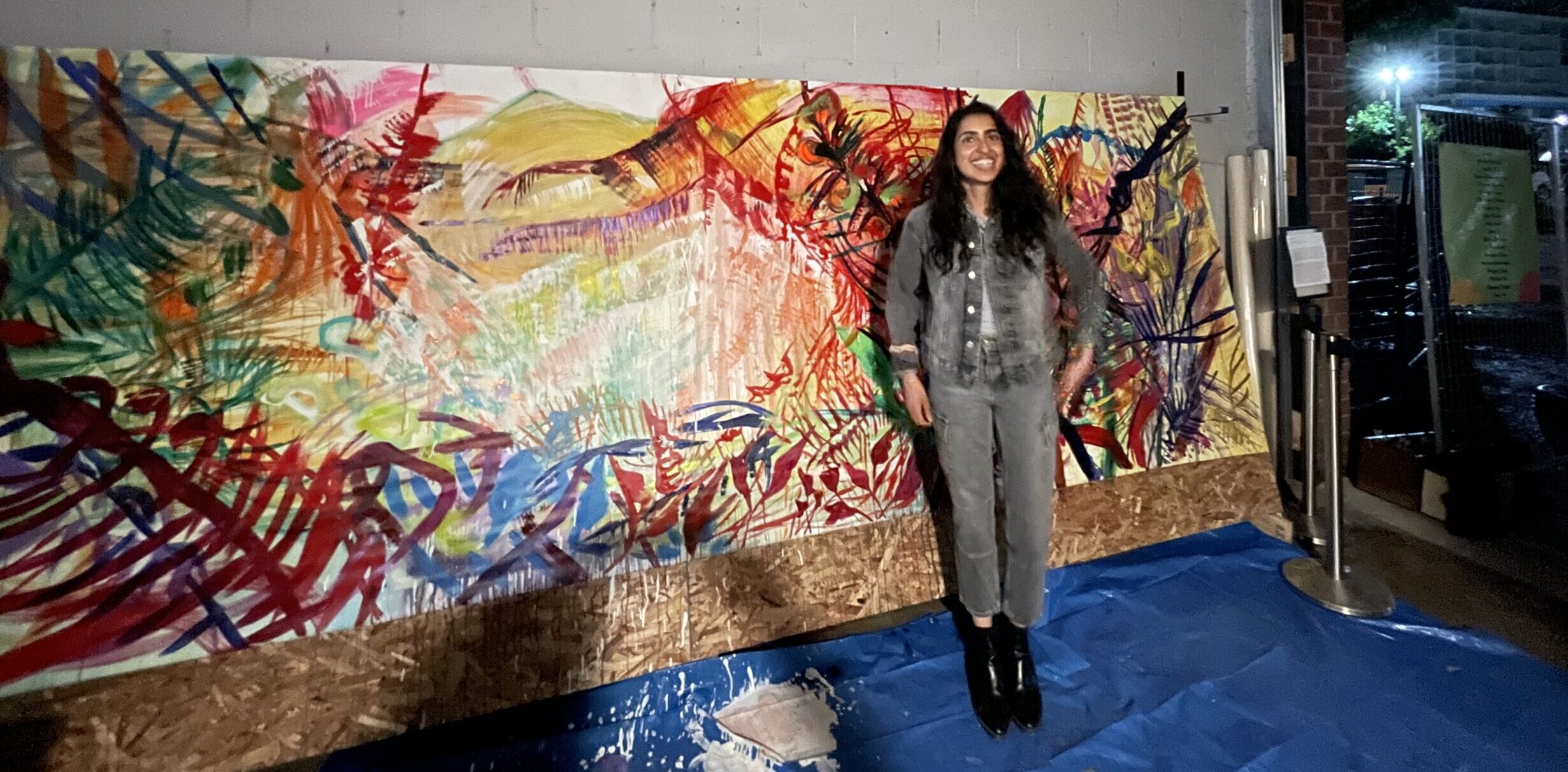
BERT WHITECROW
Miskwaabik The Protector (2024)
Sculpture Installation
19 in diameter
Miskwaabik The Protector is a hanging sculptural work embodying sound and visual storytelling elements, centring copper’s protective quality and connection to Anishinaabe culture. Artist Bert Whitecrow’s practice explores ideas of Indigenous futurisms, their relationships to place, and preserving and practicing ancestral knowledge.
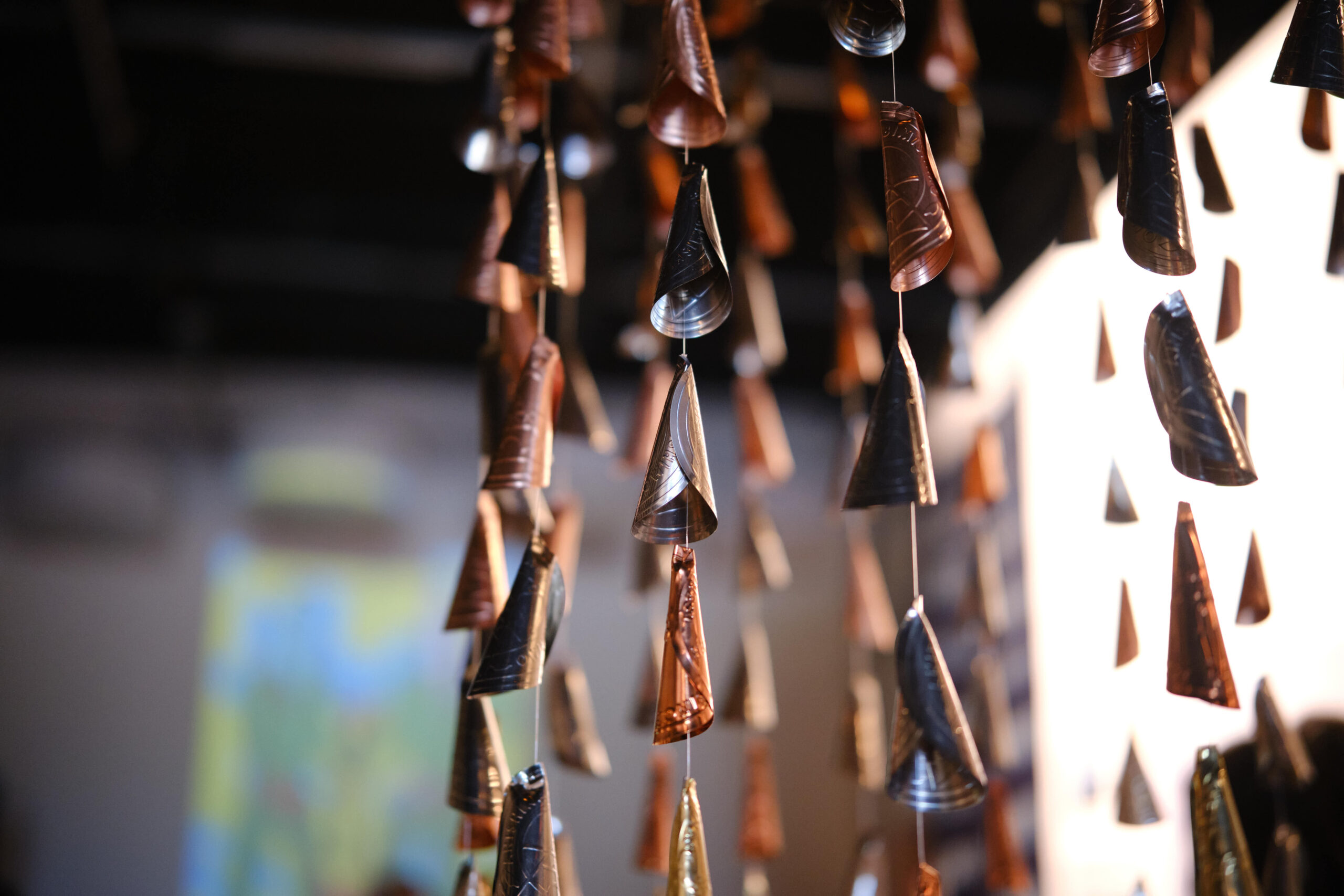

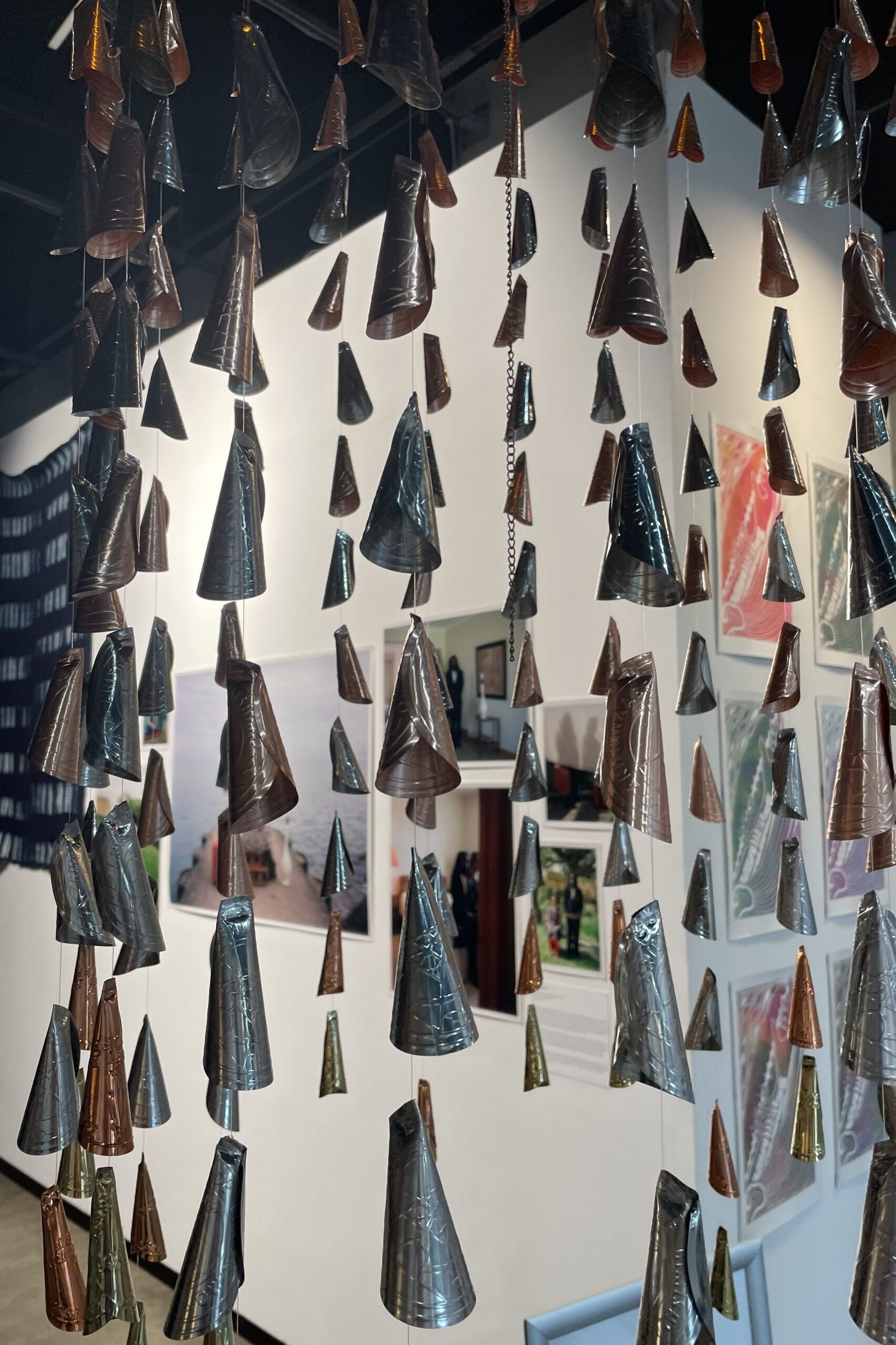
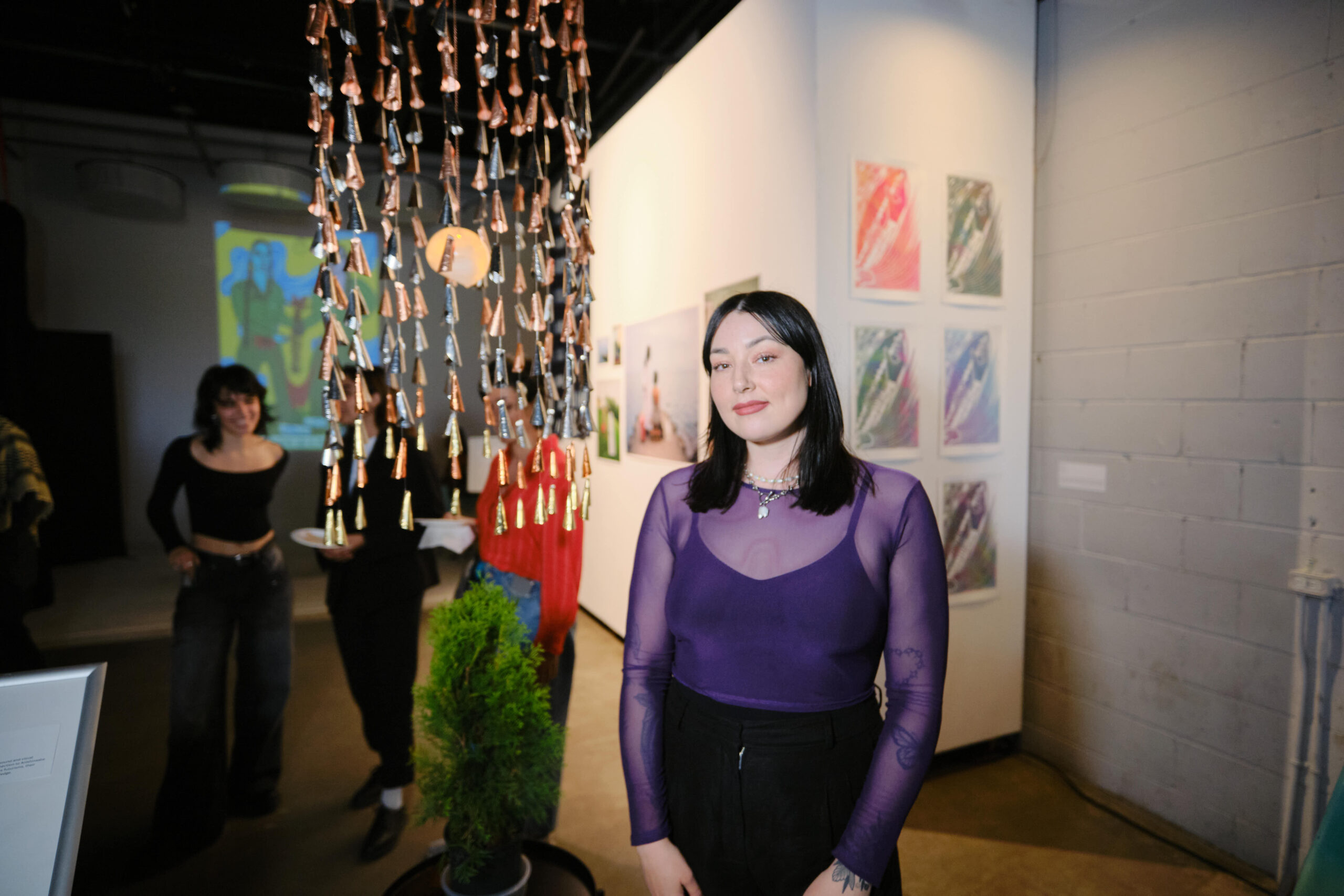
EZRA LI (E)
Queer Sex Will Save the World (2024)
Graphic Print example pages of Magazine on Cardstock
8.5 in x 11 in
Queer Sex Will Save the World is a short illustrated reflection on queer, mad, sexual healing, depicting snippets of a forthcoming work-in-progress zine discussing personal memoir regarding addiction, hyper sexuality, kink, and queer ways of knowing.
BLESSING O. NWODO
The Journey to Yourself (2024)
Immersive Installation with Audio Recording Soundscape. Mixing by Jane Doe Smith.
33:58 minutes
What would it mean to let a story be its own map and follow it where it wants to go? What would it mean to reclaim the night, that rather than being afraid of darkness because of the men that lurk in it, women become the thing in the dark that inspires terror, the thing that makes men scurry, glancing back intermittently to see if they’re being followed, before ultimately avoiding the night altogether. What would it mean to journey as a fearless little girl full of conviction, with the refusal to be diluted; melding into the older woman with wisdom, grace, and tact; then into the ancestor. What would it mean to access the ancient memory of water as central in the creation of this feminine connection? In The Journey to Yourself, artist Blessing O. Nwodo offers a witchy storyscape drawing on Igbo mythology and the Nigerian Tales by Moonlight setting to explore wealth inequality, myths of scarcity, and the power of the natural world. Proclaiming an ideal of what it means to take back the dark, in that simple yet magical act of bringing community together at night—a time when fear is supposed to rule—to weave worlds and light it up through collective imagination, joy, and the power of storytelling.
Listen To An Immersive Reading of The Journey To Yourself
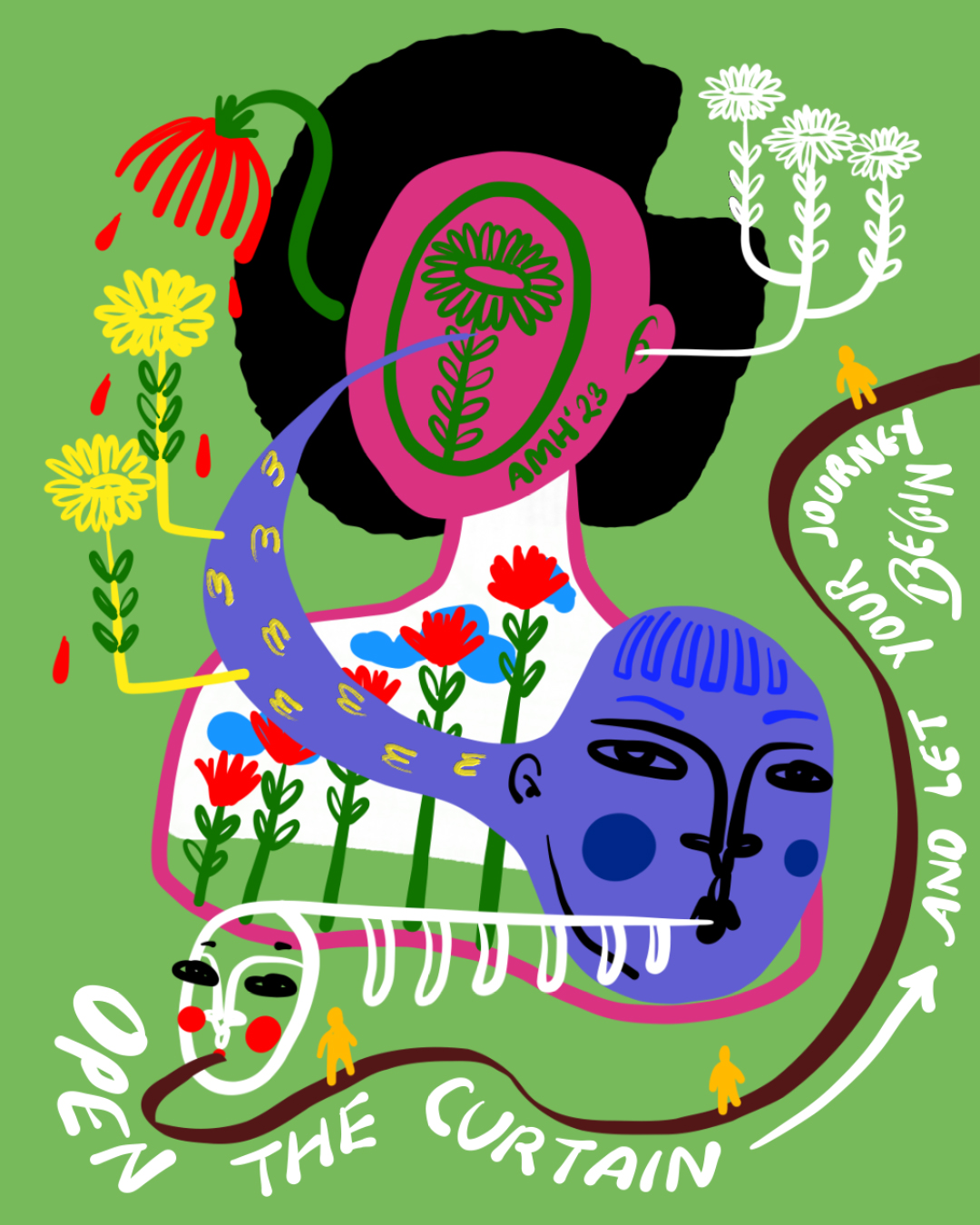
Experience the Installation
OLYMPIA TRYPIS & COLLABORATORS
Seeds of Tomorrow: Clay Jars Cultivating a Connected Future
Ceramics and Seeds Interactive Installation
Olympia Trypis and a team of diverse artists collaborated to make seed jars, housing native seeds that guests will use to make seed bombs during the exhibition. Each seed jar is made from a different colour clay, representing all the different colours people come in, and the several different biomes of our world; although our “decoration” may be different there is much more that connects people and place. Clay and seed jars connect people and diverse cultures around the world, and are a link to the past, present and future. Throughout history people from many places around the world have made ceramic vessels to house seeds. Seed jars and clay explore themes of connectivity, culture, history, the climate crisis, community, and our relationship to the natural world. The use of clay makes us artists think about where our materials come from, and the impact our art practice has on the environment and climate. Both seed jars and clay remind people of their relationship to culture, community, Mother Earth, all our relations, and ourselves. The team of artists: Olympia Trypis, Zoë Dodd, Vincy Lim, Tamika Yamamoto, and Romy Ceppetelli have also made miniature figurines that are placed throughout the exhibition, which guest will be invited to take one home to remind them to think about their relationship to the natural world around them in everything they do.

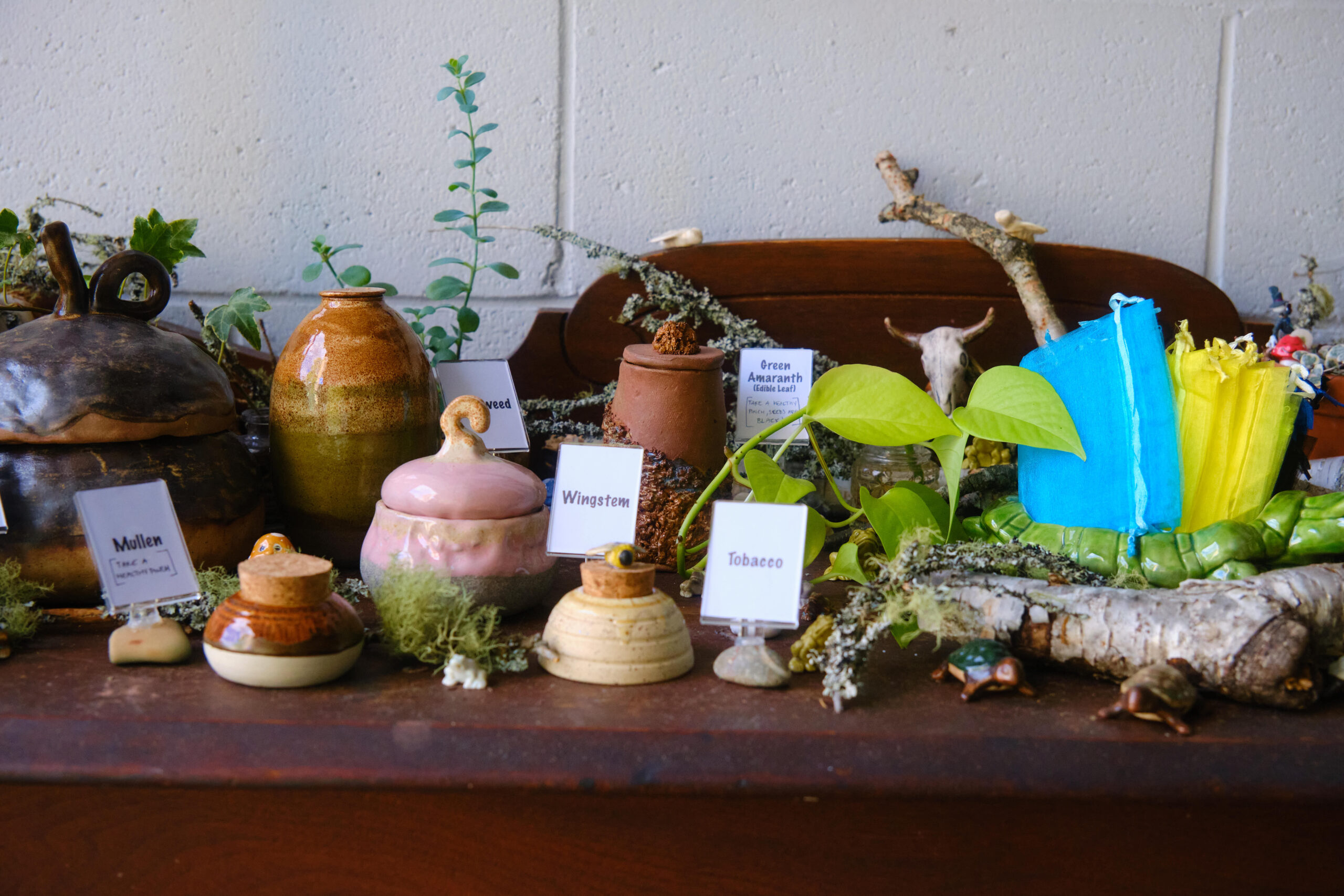

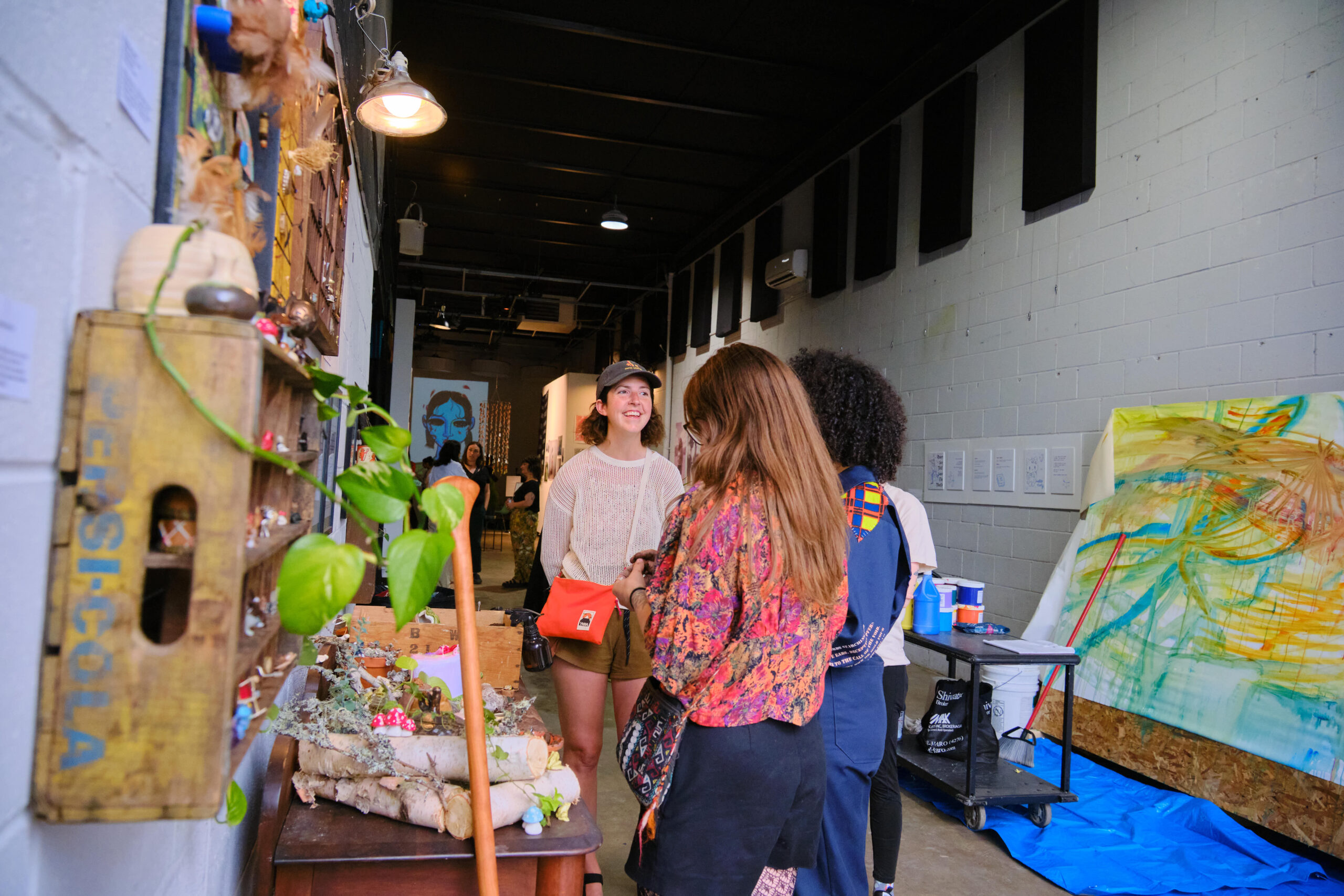
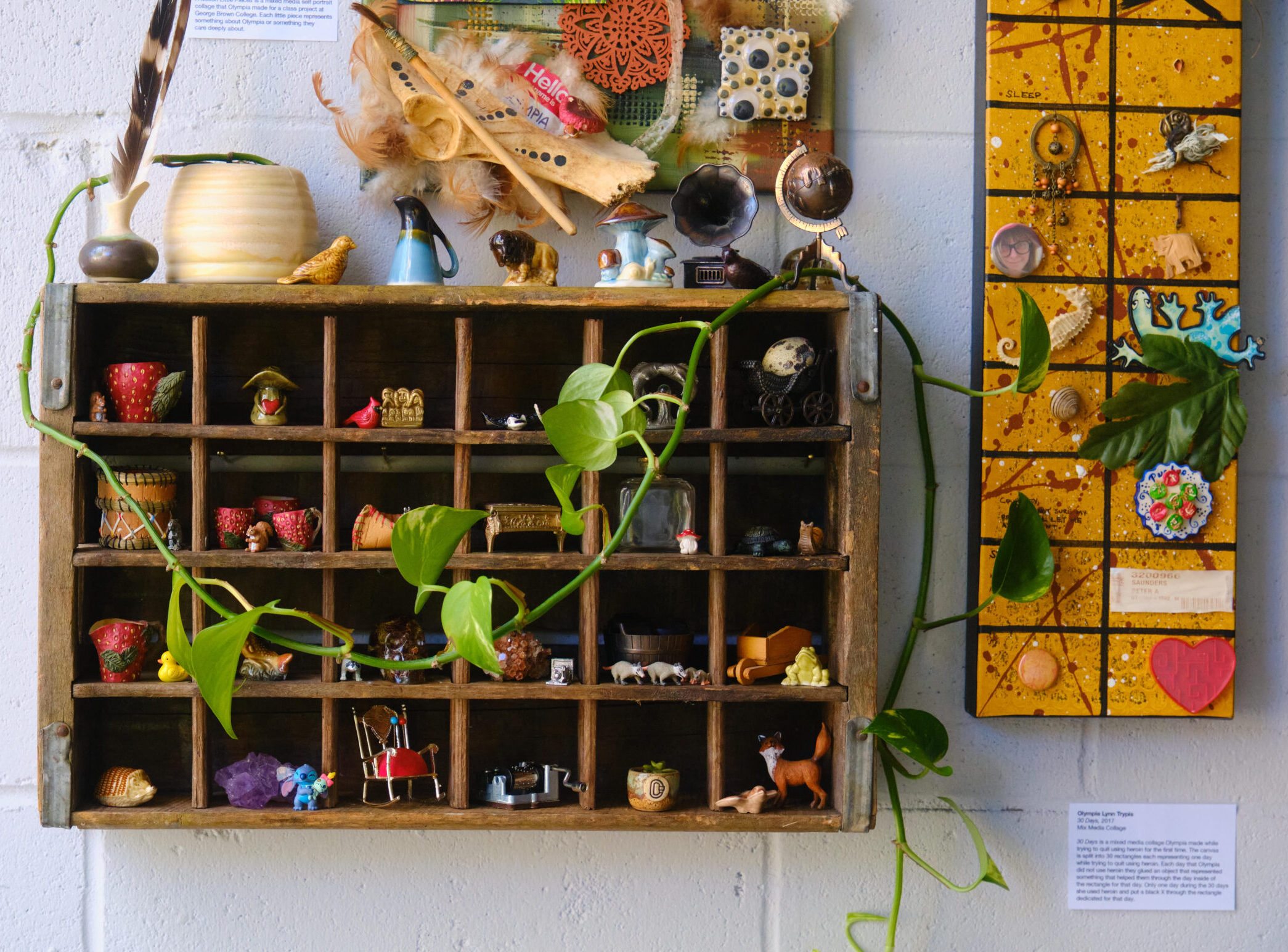
NABEELA MALIK
Was it Just Fantasy, or Did They Take the Magic Away?
Immersive Metal and Light Installation with Sound. Mixing by Jane Doe Smith.
Nabeela Yasmeen Malik’s immersive installation combines metalwork and music, to explore stillness, sadness, and relief. Through the use of light manipulation, architectural elements and language, Nabeela creates experiences that are layered in meaning and depth through a combination of scientific, historic and religious research. This installation captures finding relief through immersing oneself in nature after trauma puts us in a state of overwhelm. Trauma can make us feel isolated, and we start to doubt ourselves. In moments of relief and solitude among natural elements, we can reconnect with our personal sense of reality to believe and have conviction in our thoughts, experiences, ideas and dreams again. We can then begin to revive our vision of our inner worlds, have hope to heal, and trust ourselves to bring those dreams to life in the physical world around us.
Experience the Immersive Audio
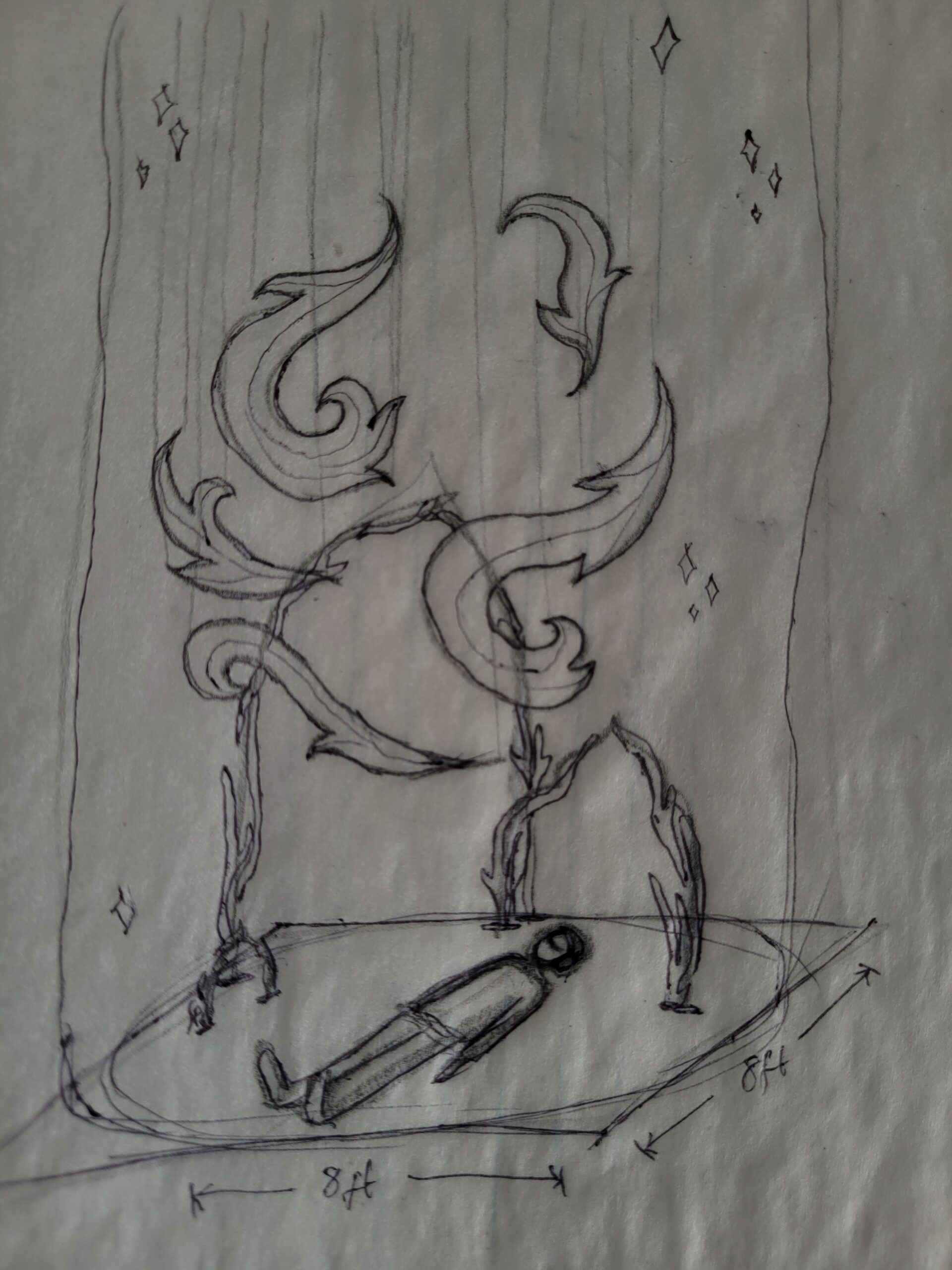
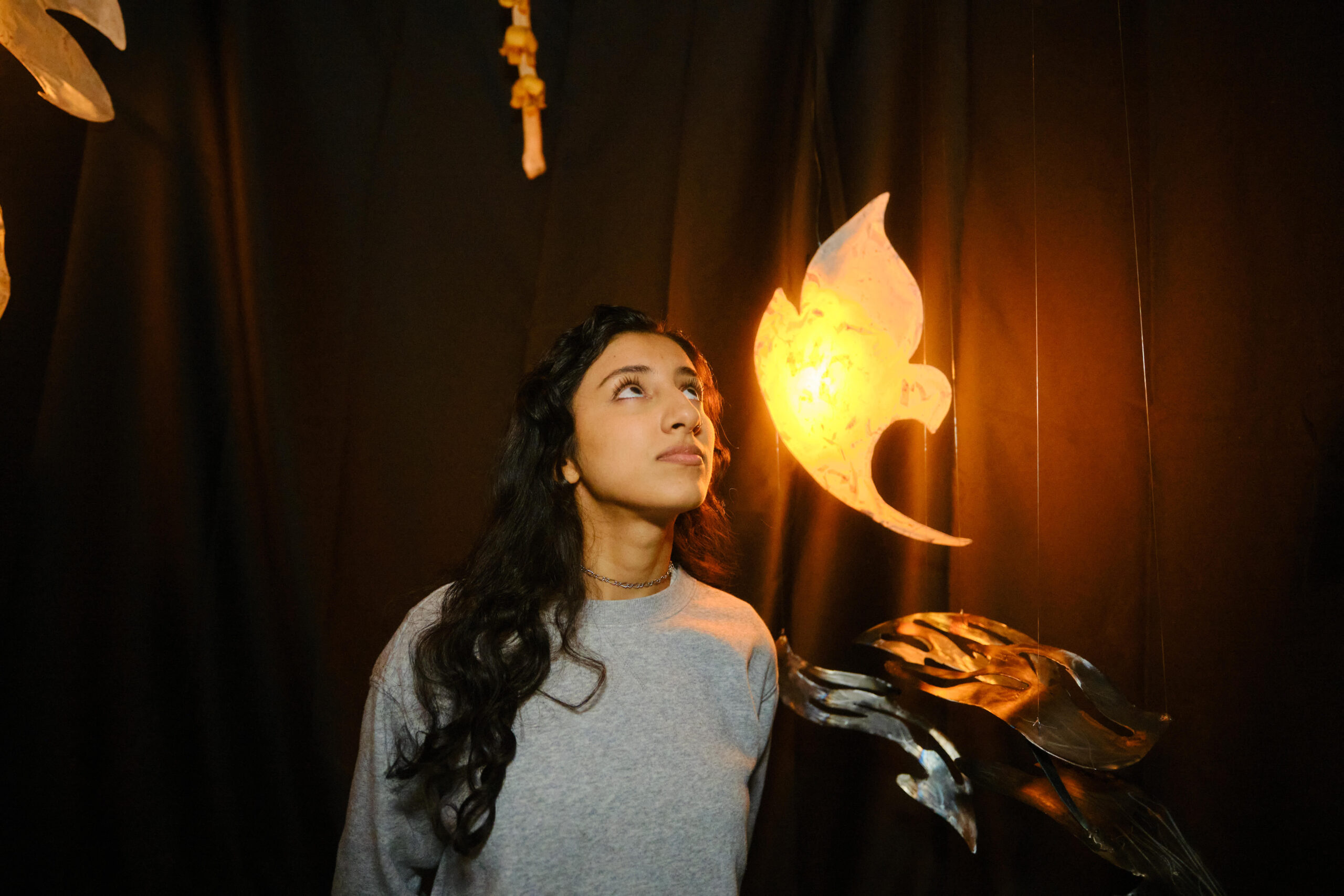
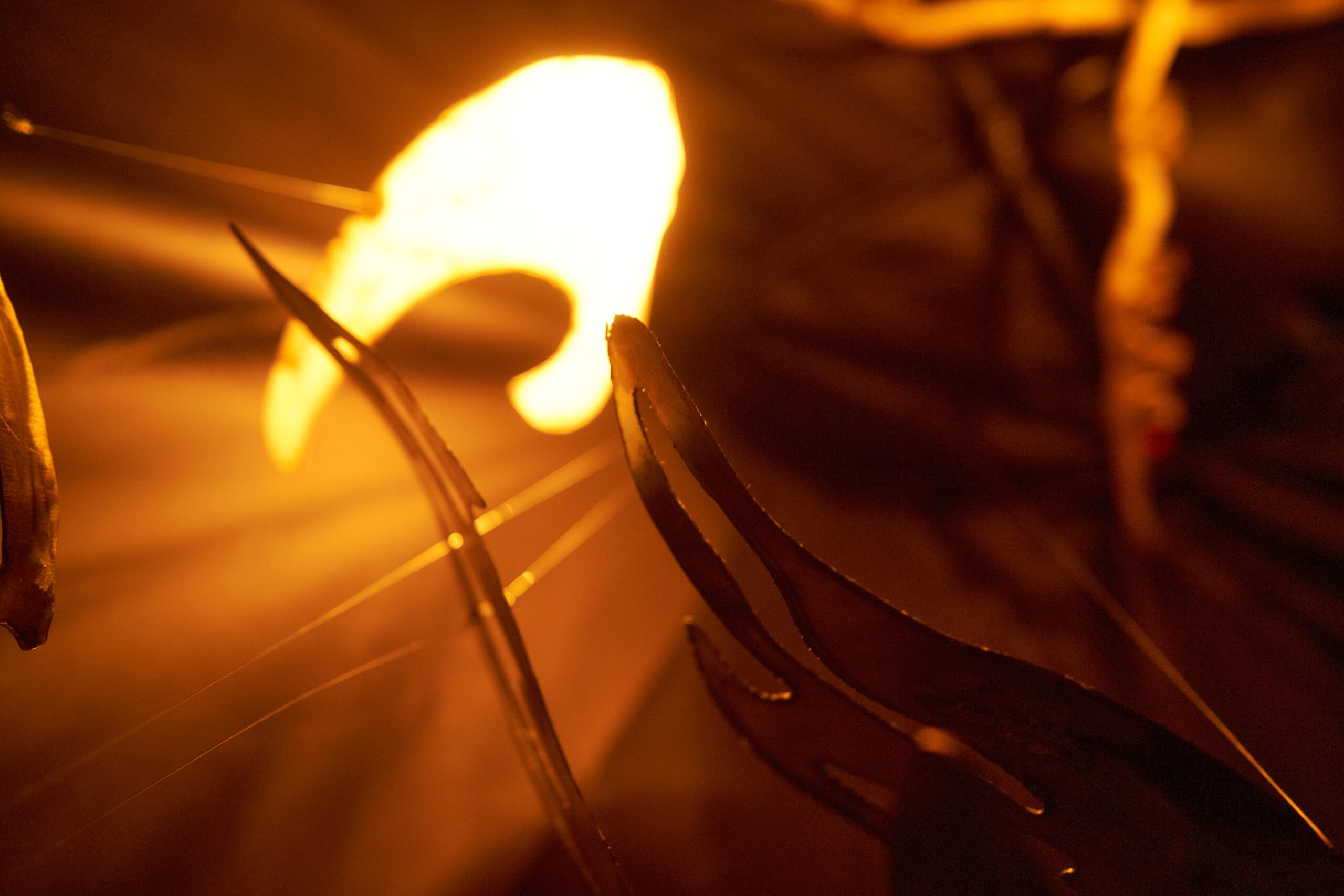
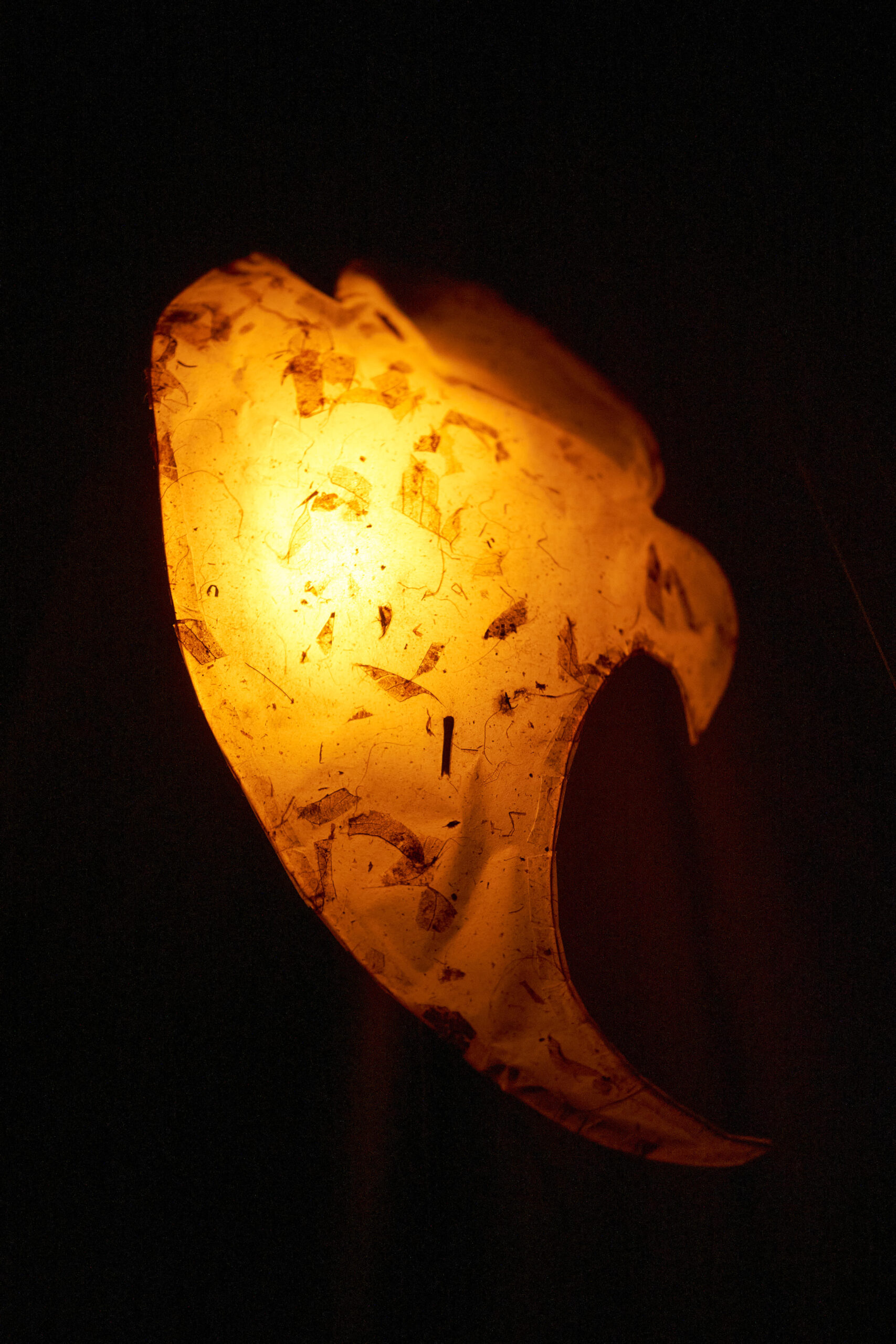
CLAIRE TRAN
The Marketplace of Dreams (2024)
Immersive Installation
The Marketplace of Dreams explores how generational immigrant experiences surface in a household. Artist Claire Tran recreates their grandparents living room as a window into this character, inviting the viewer to participate in an investigation into how culture, class, and trauma manifest in a shared space. The decided role of a “living” room can be molded and reformed by how it is decorated. What is normalized as a cozy livable space can be interpreted differently by another. The choice to source furniture from asian antique stores is rooted in Claire’s desire to give back to their community, having grown up partially in their grandparents business in chinatown, a gifts and jewelry store that would sell similar items. In this re-creation, Claire has also incorporated their own ceramics and paintings as fun easter eggs which nod to their role as a bridge between the cultures of Vietnam and Canada, and being a literal product of diaspora.
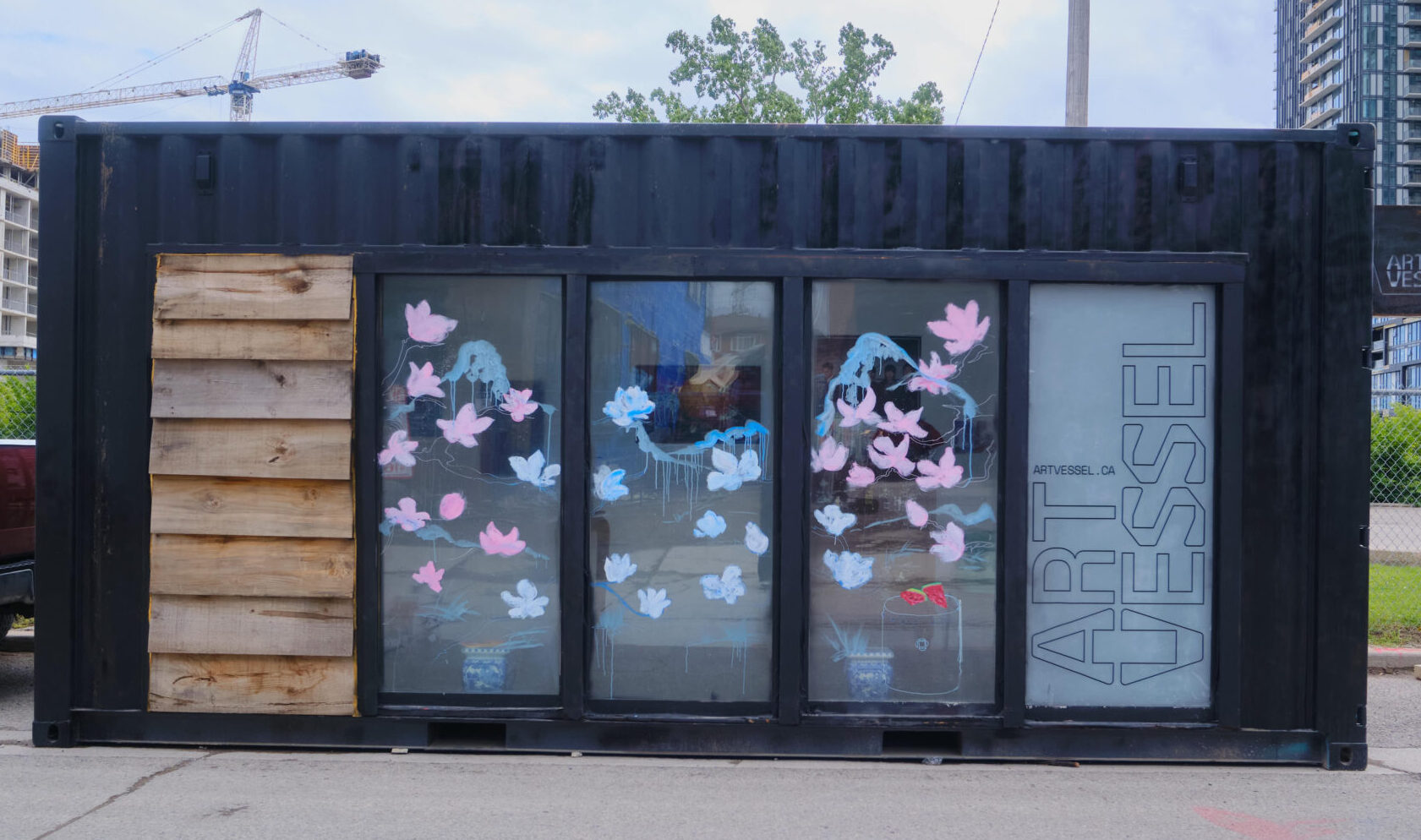
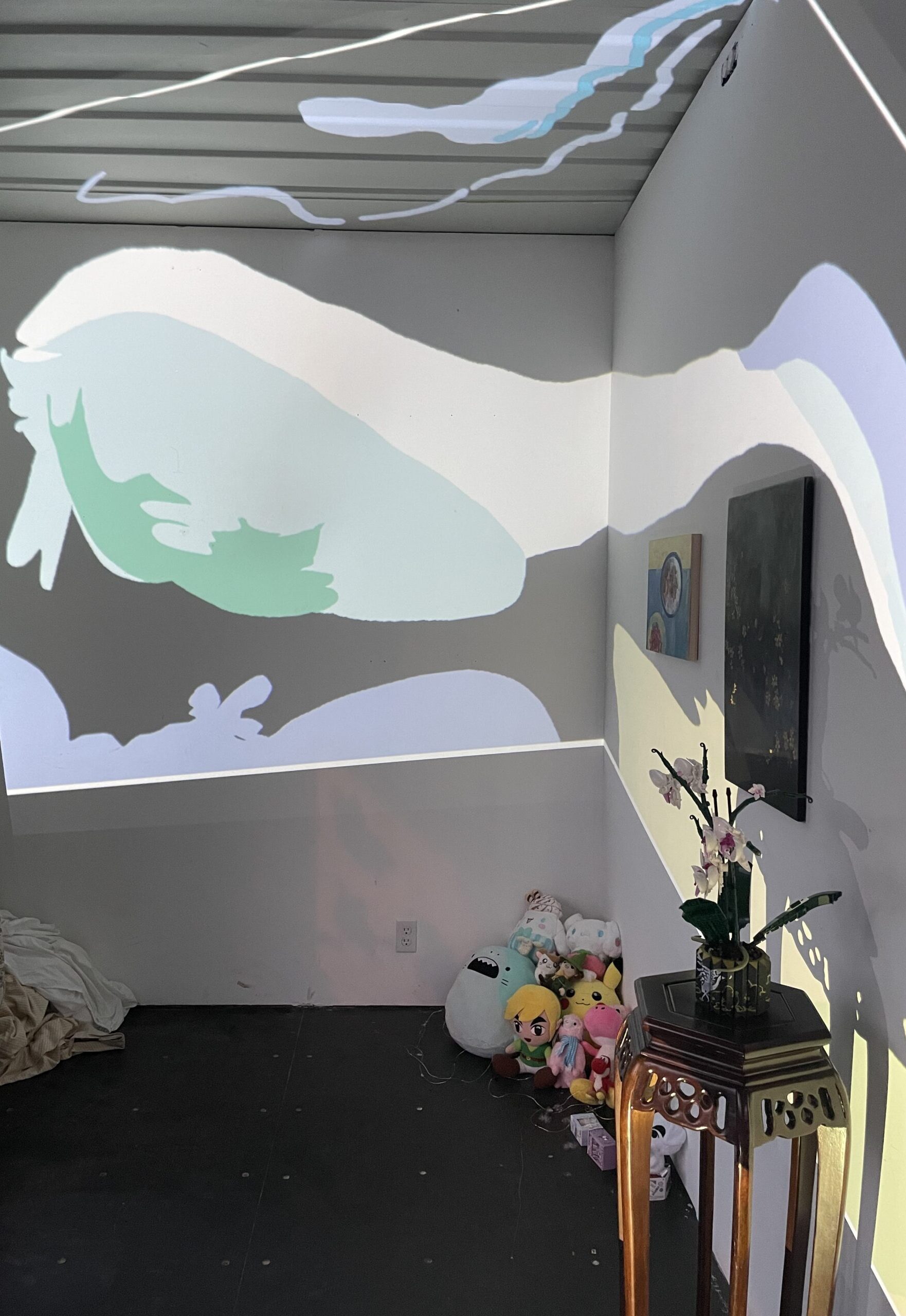
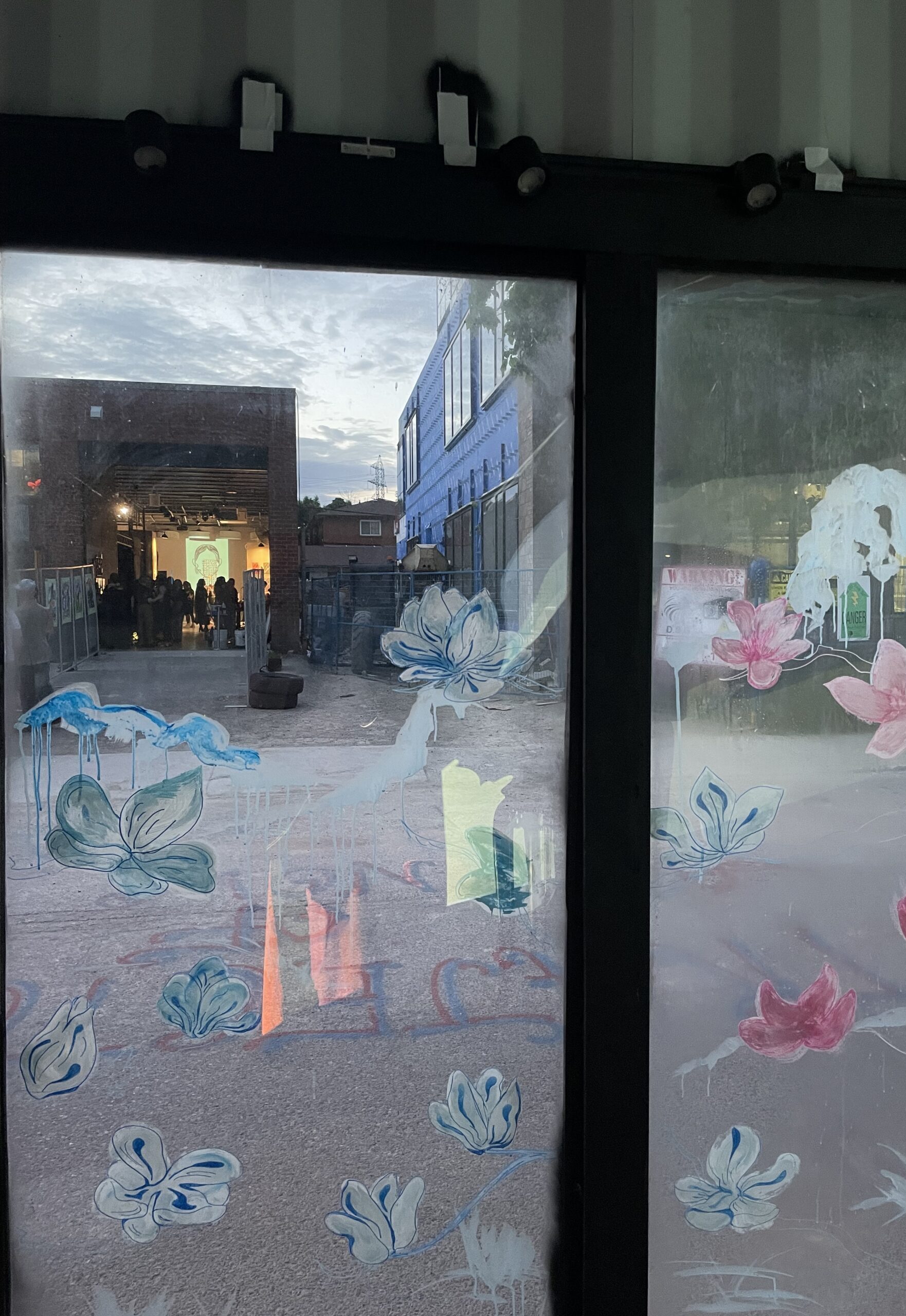
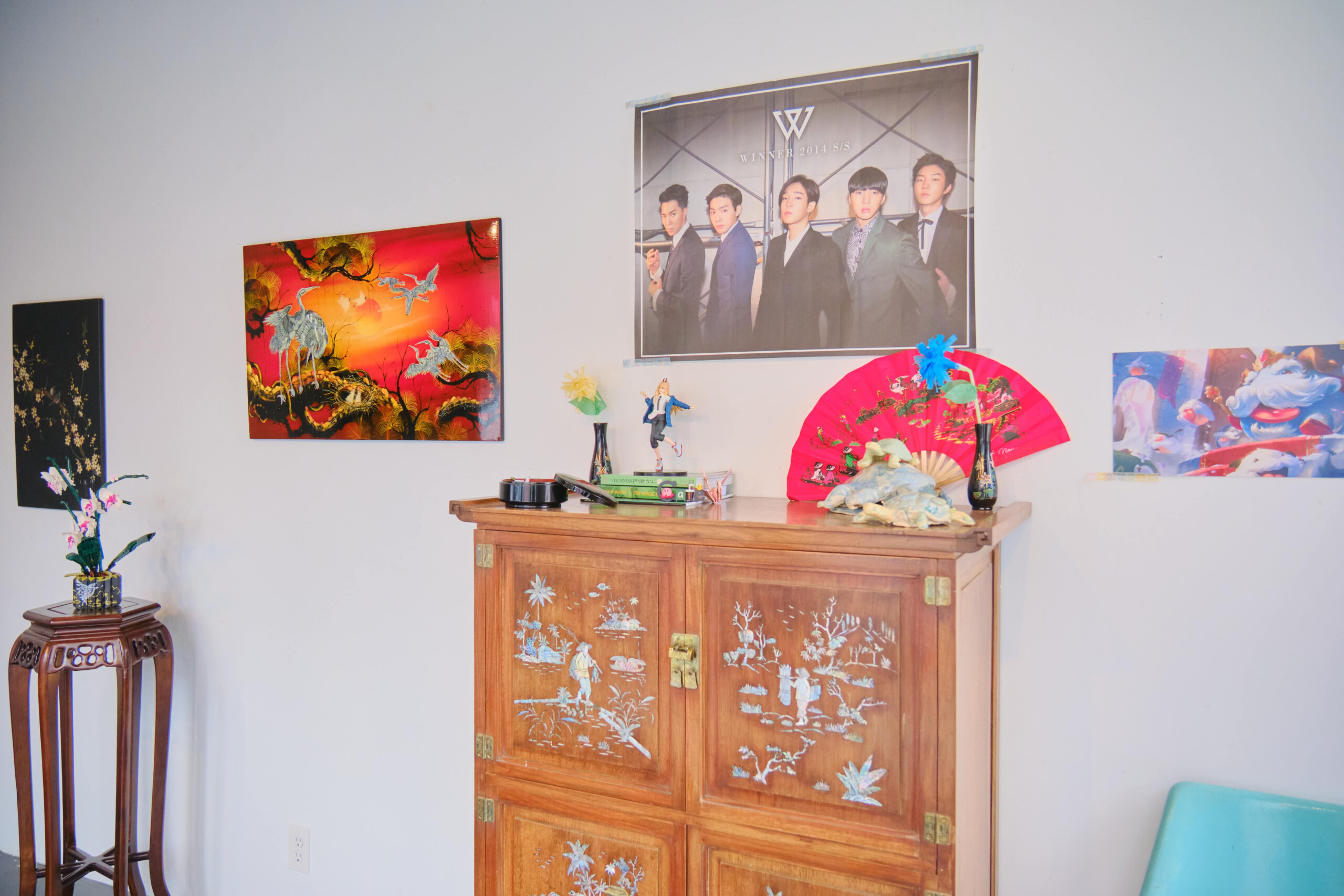
VINCY LIM
No Longer A House But A Home (2024)
Tufted rugs – Yarn on monks cloth and felt
Approx. 9ft x 3ft
No Longer A House But A Home is a tactile love piece to survivors that asks the question, “What if we were allowed to dream, and dream big?”. Vincy Lim collaborates with survivors in their found family, asking the question; “If you could be anything and everything, who would you be in a world that accepts and cares for you?” They are asked to dream about the most challenging dreams of all, themselves. As survivors, dreams are often small everyday things yet can feel so out of reach. Here Vincy encourages their loved ones to dream about everything they could be, and then actualizes these dreams into tactile forms through the means of tufted rugs. In doing so, Vincy takes these dreams and turns them real; “so that survivors and allies alike can see and know that not only do we exist, but we can learn to love ourselves in whatever form that takes, even if that is in the far future”. As participants interact with the artwork, they are invited by Vincy to join them in creating pipe cleaner flowers as offerings to their found family, and their dreams. In exchange Vincy offers back handcrafted flowers as tokens of thanks, validating participants’ continued existence. And as acknowledgement that although at times existing is difficult, it is also beautiful and deserving of love.
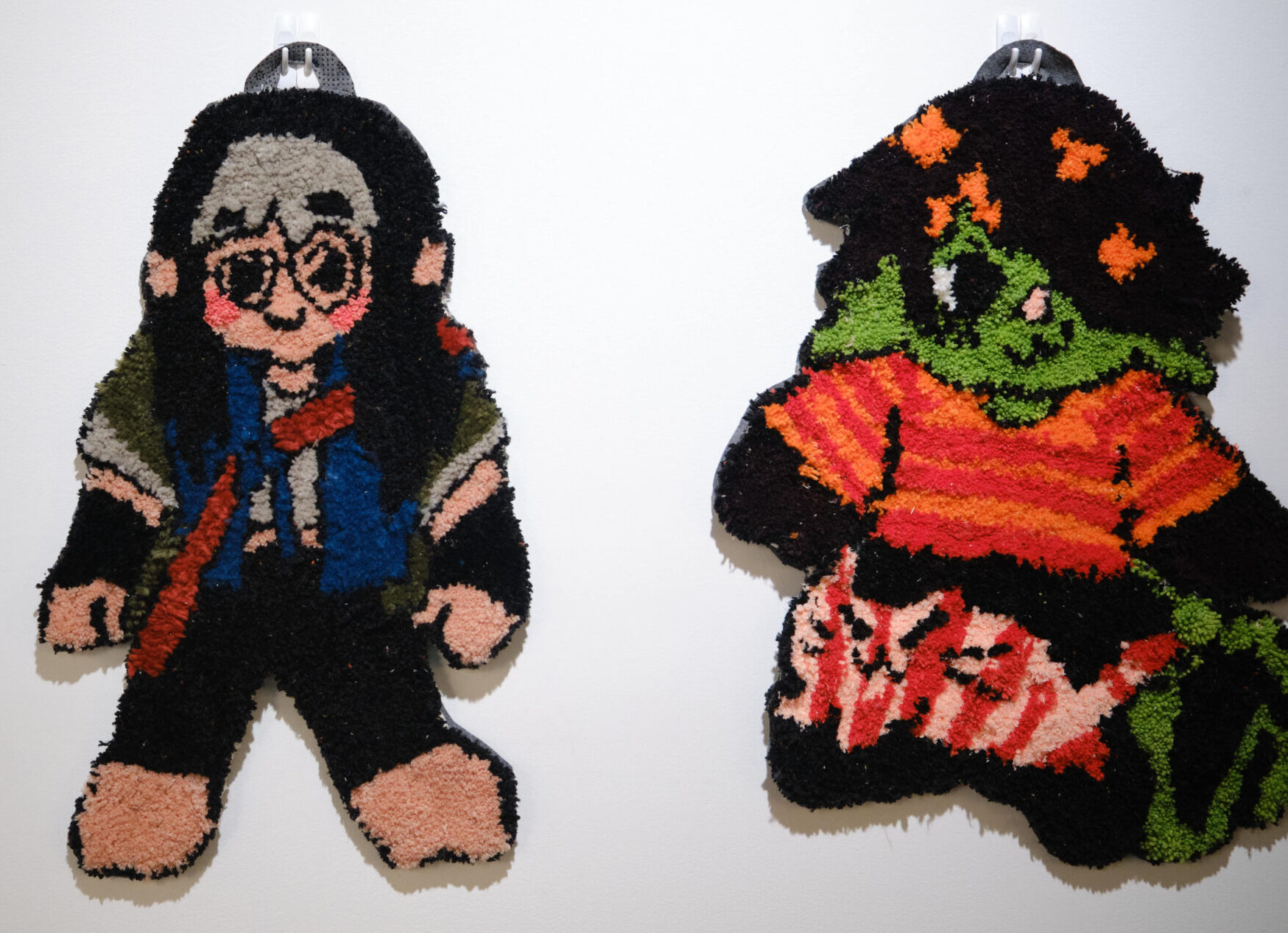

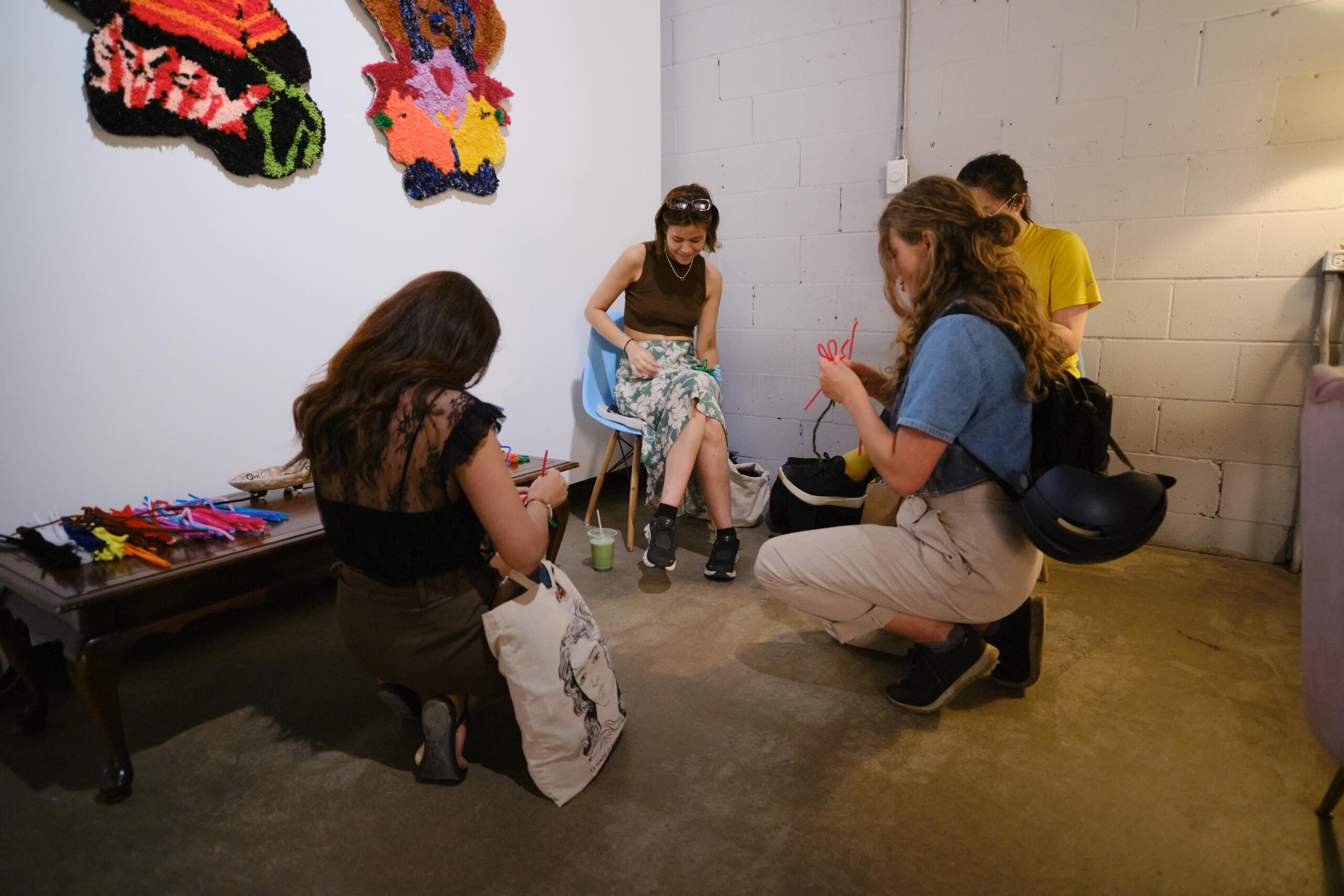
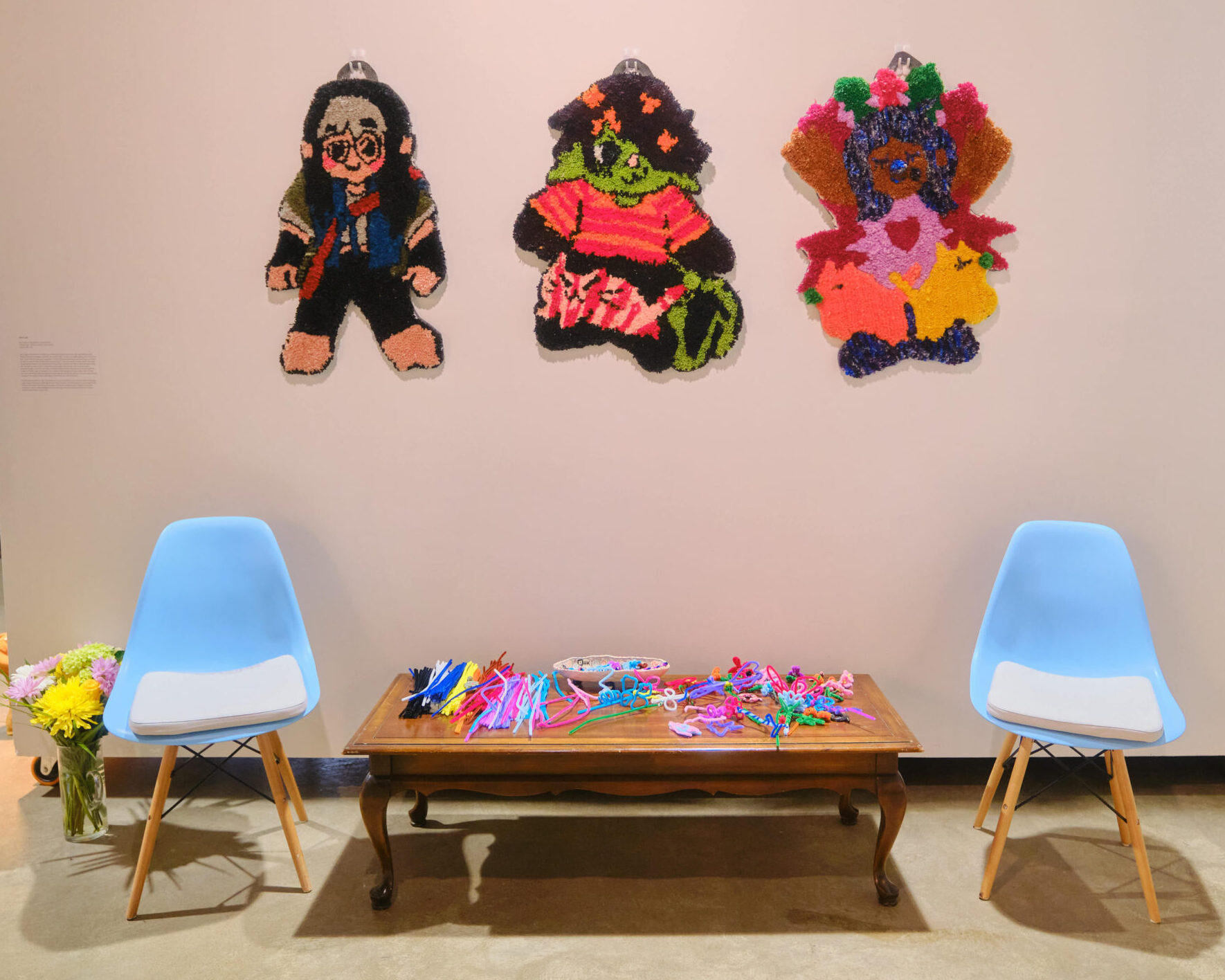
EDAN MAXAM
Untitled (2024)
Lino Print on paper
15 in x 21.5 in
Edan Maxam’s Untitled linocut uses imagery of water, palm leaves, bones and cowrie shell to discuss themes of identity and nature with a focus on how the human body can hold memory to land. Edan frequently explores personal and family history, oral storytelling, healing and activism, drawing from her experiences as an Afro Indigenous/Latinx community artist and arts educator.
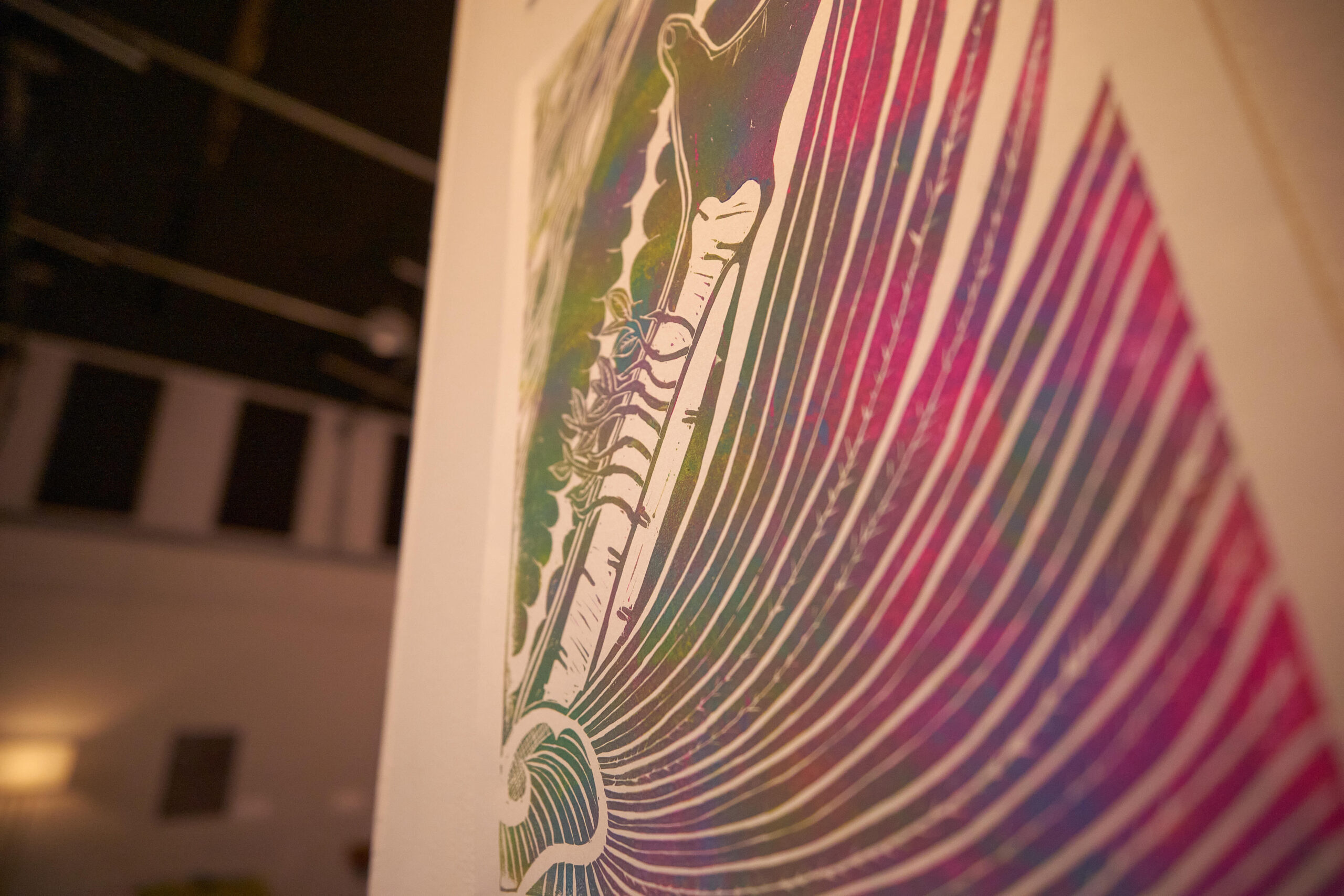


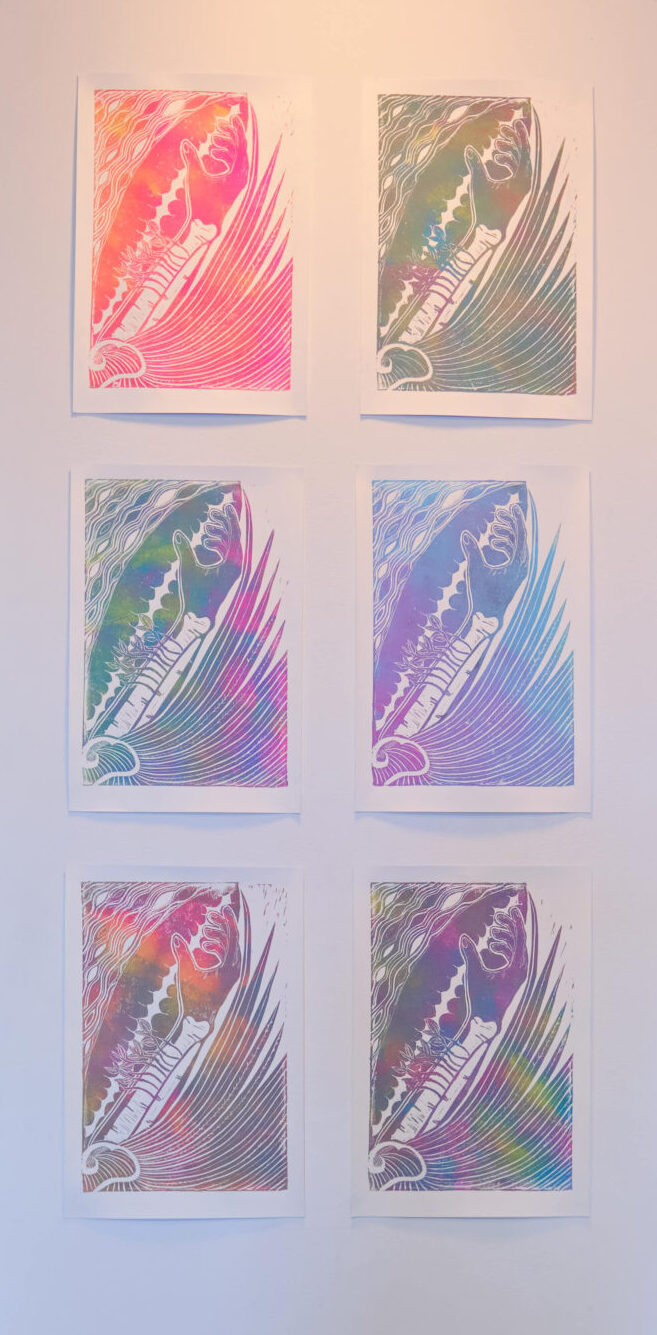
ASHLEY T
IdentiQueer Print Magazine (2024)
The Living Space for Candid Conversation Immersive Installation
Making art is and always has been a form of social change. It captures the ideas of the freethinkers into a tangible physicality that gives audiences a glimpse into other perspectives, other ways of thinking, other dreamscapes that belong to the artists built off of their lived experiences and the influence of the experiences of those who surround them. I make art for social change to attain a greater space for those still being left behind. My art is a way for me to create a legacy for myself as someone of many identities that have been left behind and forge a path forward for altering the status quo. IdentiQueer is a QTBIPOC alternative sex magazine that reshapes the narrative of desirability and the concept of what sex and sexual health includes as it presents and uplifts the lived experiences and stories of Queer, Disabled, Neuro-Spicy, Gender Expansive, and Different Bodied folks. Marketing, education, and simple perception of sex is rooted in cishet white ableist patriarchy and IdentiQueer overthrows that narrative by highlighting the different Queer/Trans BIPOC bodies that fill the spectrum of able bodied and/or neurotypical to disabled and/or neurodivergent and celebrates the destruction of the patriarchy. IdentiQueer creates space for these folks and brings them into the inclusion of the totality of the sexual landscape. The magazine includes the lived experiences of 11 QTBIPOC individuals expressed through different mediums, including personal essays, poetry, short stories, and visual art. These stories discuss subject matter of identity, sexual assault, sex work, kink culture, empowerment, disability, and desire. The included experiences dismantle the current sanitized and exclusionary concept of what sex is. IdentiQueer is a collection of inspired first-hand accounts of removing embarrassment, shame, and stigma from perceived “unconventional” sex and demands the reframing of sex as a movement to include, understand, and welcome unconventional and alternative sex as normal and desirable.
The Living Space for Candid Conversation Installation is the launch of the IdentiQueer magazine. The use of modern and upscale furnishings creates a space of current, yet mundane comfort removing the taboo of the socially undesirable and reshapes it into everyday conversational subject matter. The layout of the installation cultivates space not only for intimate conversation, but also an accessible and trauma-informed environment. The IdentiQueer magazine is available in four formats: Regular print, Braille print, Audiobook, and Audiovisual book. Regular and Braille prints are available for sale. All IdentiQueer sale proceeds will support Glad Day Bookshop and Maggie’s Toronto.
MICHELLE MA
The Jar (2024)
Dance Video
1.17 min
The Jar draws on dance and movement to explore being held, and holding. Artist Michelle Ma explores experiences of surviving, allyship and healing, and moving forward while “it is all still happening”.




